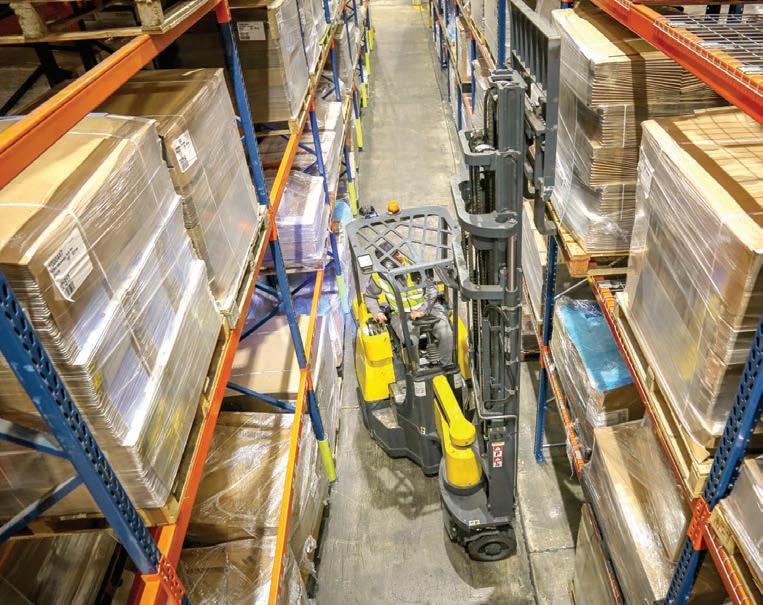
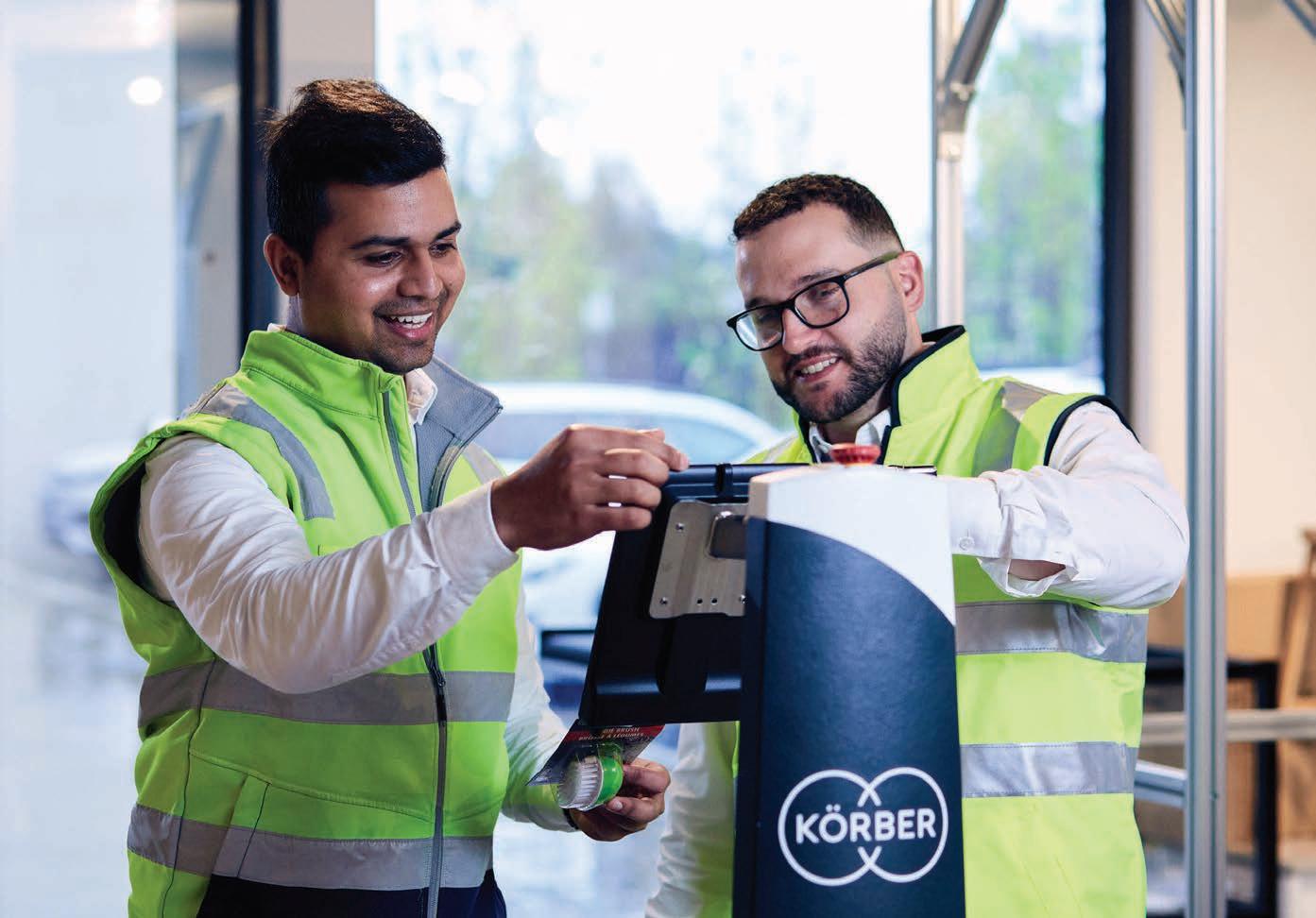




MHD Supply Chain Solutions is published by Prime Creative Media
379 Docklands Drive, Docklands VIC 3008
Telephone: (+61) 03 9690 8766 Website: www.primecreative.com.au
CEO: John Murphy
Chief Operating Officer: Christine Clancy
Managing Editor: Syed Shah
Editor: Edward Cranswick
Journalist: Joseph Misuraca
Business Development Manager: Beth Jarvis
Design Production Manager: Michelle Weston
Art Director: Blake Storey
Graphic Designers: Louis Romero, Kerry Pert
Client Success Manager: Janine Clements
Contact: Beth Jarvis beth.jarvis@primecreative.com.au
Australian Subscription Rates (inc GST)
1yr (6 issues) for $78.00 2yrs (12 issues) for $120.00 – Saving 20% 3yrs (18 issues) for $157.50 – Saving 30% To subscribe and to view other overseas rates visit: www.mhdsupplychain.com.au or Email: subscriptions@primecreative.com.au
MHD Supply Chain Solutions magazine is recognised by the Australian Supply Chain Institute, the Chartered Institute of Logistics and Transport Australia, the Supply Chain and Logistics Association of Australia and the Singapore Logistics and Supply Chain Management Society.

And just like that, another year comes to an end. It’s been a whirlwind year in supply chain and logistics. Just as we emerged from under the shadow of COVID-19, war broke out in Europe and governments across the world had to face new economic and fiscal challenges, with historically large government debts and inflation climbing to heights not seen in decades.
The MHD team had the great pleasure of attending numerous industry events in 2022 and meeting – often for the first time in person – leading industry players we’ve been writing about for years.
The sense of energy has been palpable, and as new challenges have popped into view, new product- and solutions-providers have been there to meet them.
Indeed, in this edition we spoke to the team from BALYO about how they’re making the entry into automation easy by fitting out Linde forklifts with add-on technology that turns them into AGVs – a boon for companies struggling with labour shortages and rising costs.
Also, in this edition you’ll read how Marcus Lethlean and his company Mediport have enabled effective interstate movement of pharmaceuticals with active cold chain transportation – helping to save costs and strengthen supply chain resilience in an essential sector.

And in our Cover Story for this month, we talked to leaders from the Supply Chain & Logistics Association of Australia (SCLAA) for their reflections on the year, the recent attendance record-breaking ASCL Awards in November, and what is to come in 2023. Getting back in touch with industry colleagues and partners has been vital this year, and the SCLAA has supplied the backbone of industry engagement.
From the team at MHD we wish you a wonderful Christmas and New Year. See you in 2023.
All articles submitted for publication become the property of the publisher. The Editor reserves the right to adjust any article to conform with the magazine format.
MHD magazine is owned by Prime Creative Media. All material in MHD is copyright and no part may be reproduced or copied in any form or by any means (graphic, electronic or mechanical including information and retrieval systems) without written permission of the publisher. The Editor welcomes contributions but reserves the right to accept or reject any material. While every effort has been made to ensure the accuracy of information Prime Creative Media will not accept responsibility for errors or omissions or for any consequences arising from reliance on information published. The opinions expressed in MHD are not necessarily the opinions of, or endorsed by the publisher unless otherwise stated.
Edward Cranswick Editoredward.cranswick@primecreative.com.au














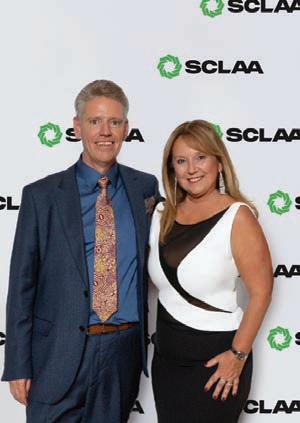



DHL Supply Chain has announced a $150 million investment in warehouse robotics solutions and automation at its Australian warehouses, which will offer several benefits.
The contract logistics solutions provider notes this initiative will support faster delivery to customers, improve operational efficiency, and reduce employee workloads.
It adds this is the largest investment in robotics and automation it has made in Asia-Pacific, with 1000 robots to be deployed by 2025.
“This is a very exciting announcement, reinforcing our commitment to the Australian market and continuous technological innovation,” Oscar de Bok, Chief Executive Officer at DHL Supply Chain, says.
“Global supply chains have been under immense pressure these past few years, and some disruption may persist. But we have invested in supply chain digitalisation worldwide, and by leveraging this global expertise, we will continually develop innovative solutions to help our customers overcome any challenges on the horizon.”
In addition to the investment in
robotics, DHL Supply Chain aims to grow its Australian workforce over two years and will provide retraining and development opportunities to existing employees.

“This investment in robotics will provide more resilient, flexible, and scalable supply chain solutions to our customers, who will be better equipped to service their own customers independent of the sector in which they operate,” Steve Thompsett, Chief Executive Officer, Australia and New Zealand, DHL Supply Chain, says.
“One thing that’s especially important to note is that this investment has been made with three bottom lines in mind, and deepens DHL’s overarching commitments to environmental, social, and governance goals,” he adds.
“For example, one of the robotic picking systems we are deploying uses one sixth of the energy of a standard household toaster. The solutions will also significantly reduce our employees’ time on routine or physical tasks, allowing more time to develop the skills that advance their careers and work on meaningful and interesting projects.”
These robotic solutions will be able to locate and deliver items to pickers faster and will allow workers to despatch more
customer orders per hour compared to a manual environment.
The robotics solutions DHL Supply Chain will deploy by 2025 include: Deployment of Assisted Picking Robots in a multi-customer environment;
• State-of-the-art picking platform, which increases storage density and order processing;
• Goods-to-Person robots, which support teams’ ability to pack more customer orders;
• Automated inventory management robot, which was developed by an Australian DHL employee; and Point-to-point picking robots, which support a diverse range of picking strategies.

Cconstruction delays and rising costs have together reduced Australia’s 2022 supply pipeline of new industrial and logistics space by 600,000 sqm, according to CBRE.
“Occupier demand continues to outstrip supply in most capital cities,” Cameron Grier, CBRE Regional Director, Industrial and Logistics, Pacific, says.
“Developers are simply not able to
bring on space swiftly enough, with long delays in planning approvals in some states and construction delays caused by wet weather and labour shortages,” he adds. “For some projects, this is adding up to delays of six to 12 months.”
CBRE Research’s Q3 2022 Industrial and Logistics report notes a downgrading of the outlook across the five major cities from 2.7 million sqm to 2.1 million sqm.
It also outlines record rental growth of 6.7 per cent quarter-on-quarter for super prime assets, with rents across all grades rising by 16 to 19 per cent year-on-year nationally, headlined by just shy of 30 per cent for Sydney’s newest facilities.
“Coupled with the lack of supply being brought to market, when you overlay some 40 per cent increase year-on-year in construction costs and softening cap rates, it’s putting

When consolidating its multiple Brisbane sites into the new Heathwood DC, Asahi made the decision to upgrade from previously very labour-intensive operations to a fully automated warehouse solution, eliminating manual handling of pallets.

With the introduction of a satellite ASRS solution, Dematic helped Asahi maximise storage capacity, reduce operating costs, and improve efficiency and productivity to better meet the needs of its customers.
Read more and watch the video at Dematic.com

even further upward pressure on rents to hit the new return hurdles of investors,” Cameron says.
A total of 654,000 sqm of new supply came online in Q3 to bring the year-to-date figure to 1.4 million
sqm – all but matching the long-term average of 1.5 million sqm – although the overall pipeline for 2022 has been downgraded, notes CBRE.
It adds construction delays stemming from wet weather and labour shortages, and rising costs based on material shortages and supply chain disruptions have delayed some projects by up to one year, with some cancelled altogether.
“Q3 was another quarter of recordbreaking rental growth in Australia’s industrial and logistics market,” Sass J-Baleh, CBRE’s Head of Industrial and Logistics Research Australia, says.
“To bring the Australian market to a state of equilibrium, around 3.7 million sqm of space is required and only 2.5 million sqm is currently under construction,” she adds. “Therefore, we can expect strong real rent growth to continue over the next three years, averaging at just over six per cent per annum.”
Australia’s national industrial and logistics vacancy rate sits at a world-
low of 0.8 per cent, with Sydney’s rate the lowest in the country at 0.3 per cent and Brisbane’s the highest at 1.4 per cent.
Of the forecast 2023 supply pipeline of 2.5 million sqm, 41 per cent is already the subject of precommitments.
Weighted-average net face rents for super prime facilities have risen by 19.2 per cent year-on-year, with the national average now sitting at $134 per sqm following Q3’s further climb of 6.7 per cent.
There have also been considerable rises for older facilities, with weighted-average net face rents for prime-and secondary-grade assets up by 18.6 per cent and 16.0 per cent respectively this year.
Sydney and Perth have recorded the largest 2022 rises to date, 29.6 per cent and 24.3 per cent year-on-year for super-prime assets, with Perth’s Q3 rise of 9.3 per cent the nation’s biggest.
CBRE says construction delays and rising costs combined have reduced Australia’s 2022 supply pipeline of new industrial and logistics space by 600,000 sqm – almost a quarter of the original forecast.
According to Colliers, increasing industrial demand outstrips supply while prime rents are forecast to grow by 30 per cent or more by 2025 in 10 industrial submarkets.
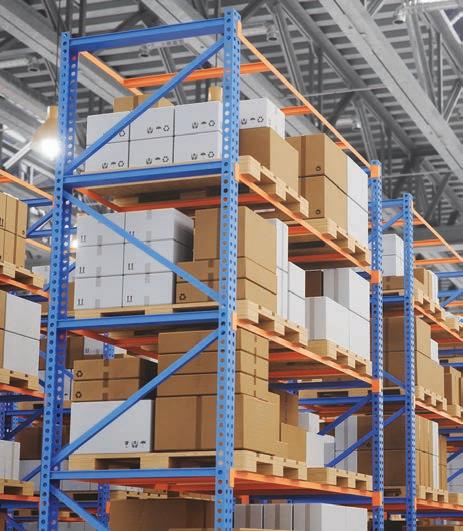
South Sydney is leading at 39.5 per cent, Central West Sydney (36.9 per cent), Outer East Melbourne (36.6 per cent) and City Fringe Melbourne (35.6 per cent).
“This is the highest level of growth since we started recording industrial rent data in 2005 and is well above the long-term average of 2.4 per cent per annum,” Gavin Bishop, Head of Industrial Capital Markets, Colliers, says.
“Sophisticated capital is increasingly seeking to optimise rents in the
context of high land values and lack of supply in infill markets with multilevel warehousing, and Goodman, LOGOS, ESR, Hale Capital Partners and Charter Hall are all currently seeking to construct multi-level facilities,” he adds.
A lack of leasing options and robust levels of occupier demand indicate that rental growth of more than 30 per cent in certain industrial markets by 2025 is likely, notes Colliers.
Gavin says this will happen since average industrial prime rents increased nationally by almost 19 per cent in the 12 months leading up to the end of September 2022.
Notable current multilevel warehousing projects due to be delivered within the next five years in Sydney include Goodman’s 45 Burrows Road, Alexandria (16,078 sqm), Charter Hall’s 520 Gardners Road, Alexandria (27,509 sqm), and Hale Capital Partner’s 42-52 Raymond Avenue,
Matraville (19,461).
“Of the multi-level industrial assets currently marketed for lease in Sydney, net face rents well in excess of $300 per sqm are being achieved for up to three levels, and the Qantas lands Colliers sold to LOGOS in 2020, which adjoins Sydney’s International Airport, will likely see Australia’s first four-to-five storey warehousing,” Gavin says.
“The Melbourne market will likely track the success of multi-level developments in South Sydney before looking to roll these out in areas like Port Melbourne over the next two to three years,” he adds.
Multi-level and larger industrial facilities answer the call for new space with vacancy rates in several Sydney areas under one per cent while also offering substantial occupancy savings as land-tax and council rates are shared across each level, notes Colliers.
It adds statutory costs account for around 55 per cent of total outgoing

costs on average, which can result in a large saving to tenants.
“Larger industrial facilities will help facilitate net take-up for 2023, which we are forecasting will be in the order of 3.2 sqm nationally, due to the impact of a shortage of leasing options and moderating demand from the retail trade sector as consumer consumption eases with the rise of the cost of living,” Luke Crawford, Director Research, Colliers, says.
“With regards to speculative projects, between now and the end of 2023, there is approximately 1.6 million sqm in the pipeline along the East Coast, dominated by the Melbourne market,” he adds.
“Of this amount, almost 50 per cent is committed with the bulk of uncommitted space stemming from 2023 likely to be committed closer to completion.
“Given rents are increasing on
a weekly basis at present, select developers are not wanting to lease the space months before completion as they believe they are missing out on rental growth, while others are happy to lease the space to provide outcome certainty.
“Since the substantial speculative pipeline over the next 18 months is far exceeded by the level of active tenant requirements, it is unlikely to significantly impact vacancy rates.”

FedEx Express ANZ is collaborating with Starshipit, a shipping and fulfilment platform, supporting small and medium enterprises (SMEs), which allows e-tailers to tap into the international e-commerce market.

It notes merchants integrating FedEx and Starshipit will enjoy enhanced shipping and fulfilment automation, with access to a premium delivery experience for their customers at competitive rates.
“Our recent e-commerce research shows that e-tailers are increasingly looking for digital solutions which strengthen their delivery capabilities and allow them to grow their exports by tapping more international customers,” Peter Langley, Vice President of FedEx Express Australasia.
“Our collaboration with Starshipit is yet another example of how we are strengthening our capabilities within the e-commerce ecosystem to help small- and medium and e-commerce businesses in Australia and New Zealand,” he adds.
Starshipit customers can generate FedEx shipping labels and use additional features, such as Express Shipping Services and International Shipping Documentation Service, without leaving the Starship platform, notes the express transportation company.
“Our integration with FedEx makes streamlining shipping and fulfilment easy for e-commerce retailers,” Hakan Steele, Partner Manager at Starshipit, says.
This simple and easy-to-use integration of FedEx and Starshipit accounts enable e-tailers easy and automated access to process orders.
“Using Starshipit and FedEx together empowers retailers to save time with automation and deliver great shipping experiences,” he adds.
This simple and easy-to-use integration of FedEx and Starshipit accounts enable e-tailers easy and automated access to process orders.
FedEx says e-commerce in ANZ is expected to annually grow at five per cent and six per cent, respectively.
The latest e-commerce trend report it commissioned also indicates Australian
SMEs are using e-commerce more and agree the pandemic-driven utilisation of e-commerce is permanent.
It notes eight in 10 SMEs believe e-commerce will become more important in their business over the next three years, with nine in 10 SMEs believing they are well positioned to capitalise on this growth. Seventyseven per cent agree e-commerce will continue to become even more important in the future.
Market leading expertise to maximise the potential of industrial property. Experts choose experts.
We look forward to accelerating the success of our clients in 2023.

Coles is Australia’s first major retailer to offer drone delivery directly from its store to customers’ homes after launching a pilot service in South East Queensland with global, on-demand drone delivery company, Wing.

From Wednesday November 2, its customers in the Gold Coast suburbs of Ormeau, Ormeau Hills, and Yatala are now among the first to pilot the storeto-door drone delivery model, offering grocery delivery in minutes, directly from the Coles store at Ormeau Village Shopping Centre.
“We are delighted to be expanding our drone delivery pilot program with Wing to our Queensland customers,” James Geddes, Coles Head of Network Development and Customer Delivery, says.
“The service will provide a convenient and effective way of delivering everyday



essentials to our customers’ homes in a matter of minutes,” he adds.

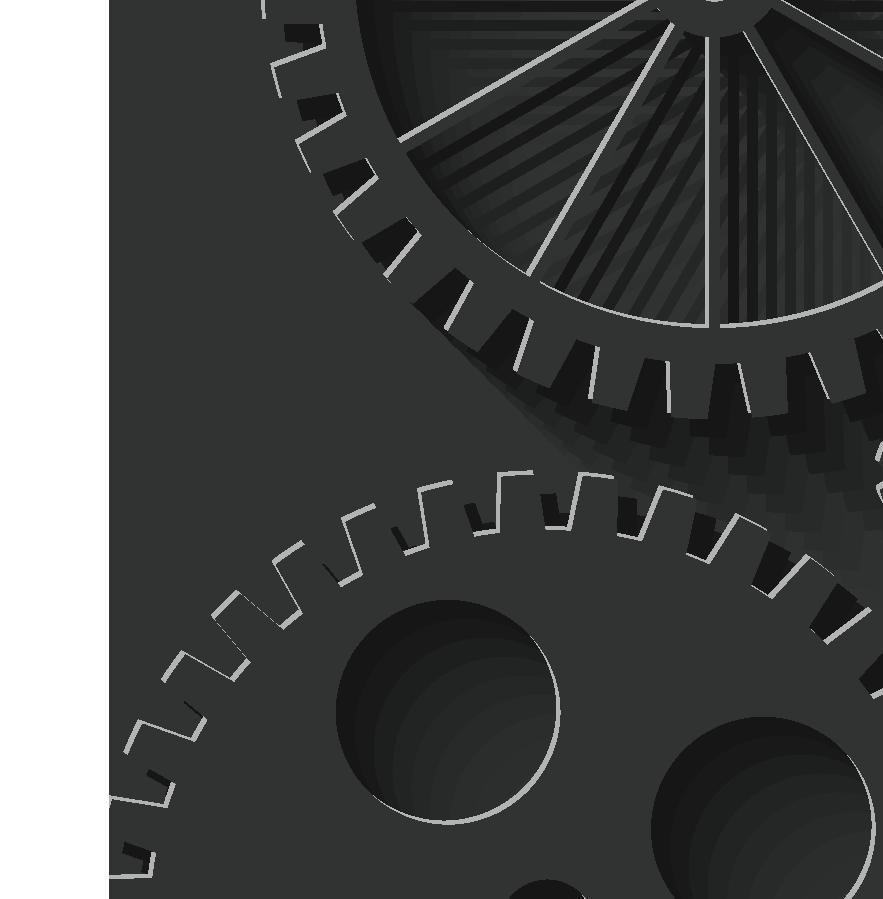
Coles notes it has a dedicated fleet of Wing delivery drones co-located in its store car park. Its team members can process and pack orders while Wing staff can load the drones and oversee operation of the delivery service.
The grocery giant says the service will gradually expand to include other nearby suburbs, delivering 500 of its most popular grocery items including bread, fresh produce, convenience meals, snacks, healthcare items, and household essentials.
“We’re excited to be teaming up with Coles on this Australian first store-todoor drone delivery service, helping to expand the delivery options available to Coles customers by bringing affordable, sustainable, and fast drone delivery to the skies of South East Queensland,” Simon Rossi, Australian General
Manager, Wing, says.
“Since launching our drone delivery service in Logan a few years ago, we’ve heard from customers across South East Queensland who are keen to see drone delivery expand to their region,” he adds. “We’re delighted that through this pilot program with Coles, for the first time, drone delivery will be available to residents in the City of Gold Coast.”
As part of the expansion into South East Queensland, Wing will also soon offer Coles items for delivery from the rooftop of Grand Plaza in Logan, Queensland, where it has been operating a drone delivery service for selected on-site businesses for more than a year.
The Gold Coast area is the third Australian region where Wing drone delivery will be available, having previously been available to residents in parts of Canberra, ACT, and Logan, QLD, since 2019.


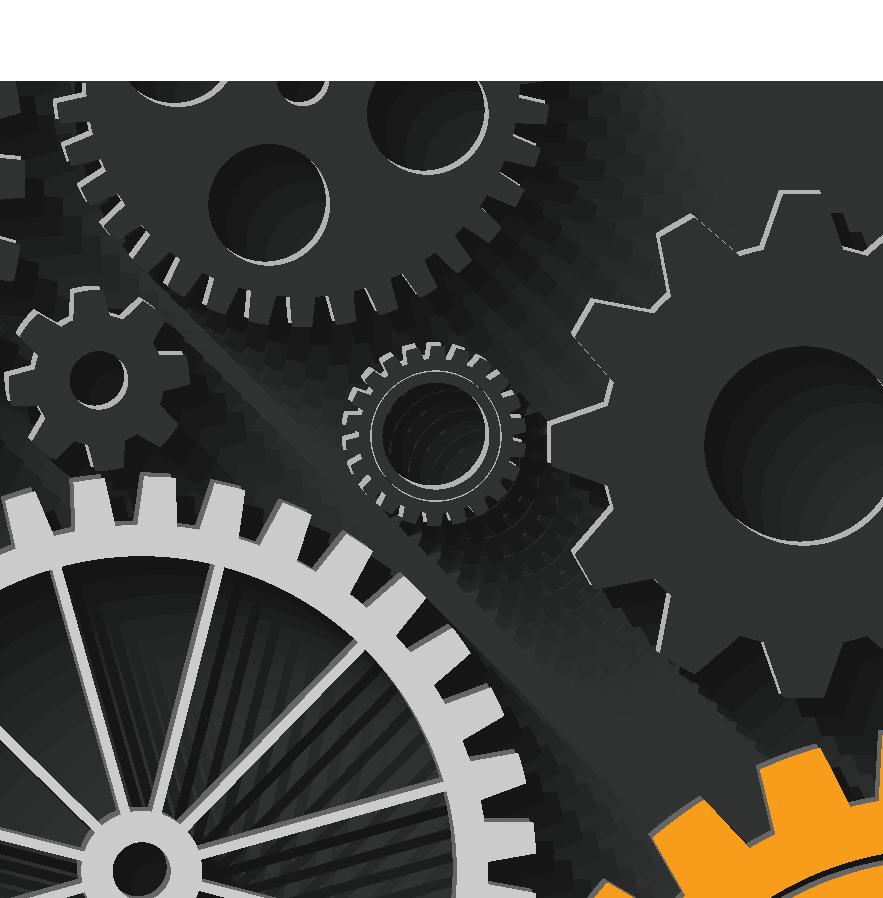




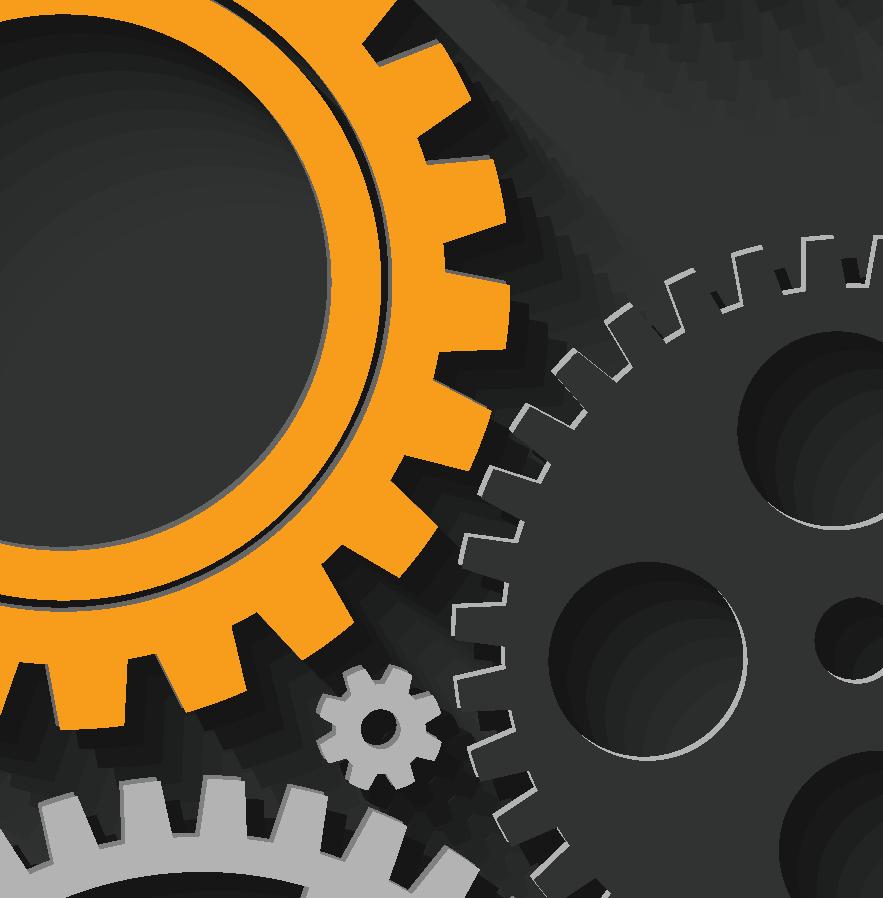













The Inside Construction Expo is scheduled for 20-21 September 2023 at the Melbourne Convention and Exhibition Centre where it will help construction and other related industries “engineer the future.”
The construction industry is a critical pillar of the Australian economy, producing upwards of $437 billion in revenue and approximately nine per cent of the nation’s Gross Domestic Product in 2022.
The sector has a projected annual growth rate of 2.4 per cent over the next five years and as it grows, so does the requirements of lifting, handling and transportation and building automation. The boom of the construction industry directly affects and assists the supply chain and logistics industry.
With investments in new and existing infrastructure projects in every state and territory, the Australian government’s national rolling 10-year infrastructure investment pipeline will increase from $110 billion to $120 billion, significantly boosting the sector.
Featuring an exhibition, conference, and awards across the two days of the expo, the 2023 Inside Construction Expo: ‘Engineering the Future,’ presents an ideal environment to focus on and discuss answers to the significant challenges facing both the construction
The conference will focus on major projects and civil construction, with the conference and world-class exhibition providing a platform for construction equipment and companies.
industry and by extension the supply chain and logistics industry.
With focus on the skills shortage in the construction sector, the continuing digital transformation of the construction industry and the overall safety values in the construction industry, the expo is an opportunity for the whole industry to connect.
The conference will focus on major projects and civil construction, with the conference and world-class exhibition providing a platform for construction equipment and companies, alongside industry leaders, to present ideas and
equipment that are best suited to the current concerns in the industry.
The centrepiece to the event will be about Victoria’s Big Build, expanding out to showcase construction on other significant infrastructure taking place around Victoria.
With the exhibition spanning 15,000 sqm across 10 bays at the Melbourne Convention and Exhibition Centre, Inside Construction Expo provides the best opportunity to meet with your target audience.
If you specialise in one of the following areas, Inside Construction Expo is right for you.
Site Equipment
• Construction Technology
• Lifting, Handling & Transportation
• Subsurface, Quarrying & Mining Plant, Machinery & Vehicles
• Urban Design & Landscaping
• Sports & Playgrounds
• Building Envelope
Building Interiors & Finishes
• Building Automation
• Construction Tools
• MEP Services
Heating, Ventilation & Air Conditioning
For more information visit www. insideconstructionexpo.com.au
NSW Ports says it has outlined its strategy for moving more freight by rail to enhance efficiency while reducing emissions and road congestion at the Australasian Railway Association Rail (ARA) Freight Conference.
Port Botany is Australia’s only container port with on-dock rail at each container terminal and moves more containers by rail than any other port in the country.
Jonathan Lafforgue, NSW Ports General Manager of Operations and Environment, says Port Botany’s rail moved more than 400,000 TEU a year – up 64 per cent since 2014.
He adds NSW Ports had the right strategy in place to continue optimising and growing rail capacity.
“NSW Ports is investing in extra rail capacity to address long-term demand in a sustainable way, by reducing CO2 emissions and the use
of trucks, as trade volume increases,” Jonathan says.
“Together with Patrick Terminals, we are investing $190 million to substantially boost on-dock rail capacity, which will deliver faster turnaround times, more rail windows for operators and allow more containers to be moved by rail to and from the terminal without the need for double handling.”
NSW Ports says Jonathan spoke at the
ARA conference about the need to build and optimise rail freight connectivity to enhance the sustainability, efficiency and productivity of the nation’s supply chains.
Part of its strategy to maximise the capacity and efficiency of rail freight includes:
Expanding Port Botany’s on-dock rail capacity to meet future container growth demand

• Increasing the two-way loading of trains, including with empty containers, to improve rail
utilisation and efficiency, and reduce CO2 emissions
• A mode shift incentive scheme, funded by Transport for NSW, to incentivise regional exporters to use metropolitan intermodal terminals for the “last mile” journey to Port Botany and collection of empty containers
• Working with businesses, rail operators and Transport for NSW to improve access to the shared metropolitan rail network for trains destined for Port Botany
Port Botany is Australia’s only container port with on-dock rail at each container terminal and moves more containers by rail than any other port in the country.
“Utilising Port Botany’s dedicated freight rail lines and on-dock rail terminals more strategically, by boosting two-way loading of trains and optimising the benefit of intermodal terminals, will help ensure we continue to meet the growing needs of businesses and their customers,” Jonathan says.
“A mode shift incentive scheme is one way to kickstart this process, with jurisdictions such as Victoria and Western Australia showing that such schemes can successfully increase the volumes of freight on rail.”

With booming membership in 2022, record attendance at its Awards and networking events, and new programmes and initiatives in store, the Supply Chain & Logistics Association of Australia has had a great year – and is gearing up for an even greater one in 2023. MHD spoke to Sue Tomic, Chair of SCLAA, Stephen Lakey, Independent Director & Chair of the 2022 ASCLA Awards Committee, and Rakesh Bandipelli, State Director of the Victorian and Tasmanian Division, for their reflections on the year that was, and the year to come.
oming out of the COVID lockdowns, we hit back with a vengeance with our Awards night in March,” says Sue Tomic, Chair of the Supply Chain & Logistics Association of Australia (SCLAA). “Our March Awards set a record for attendance, and our November Awards broke that record again.”
As Sue remarked in her speech at the November Australian Supply Chain & Logistics Awards, the only reason there weren’t more than 450 people in attendance was because they’d maxed out the venue’s space.

And what was true of SCLAA’s Awards nights was true of SCLAA in general in 2022, with outstanding growth in memberships and numbers of events – to speak nothing of qualitative improvements such as a successful rebrand at the start of this year and a new slate of membership offerings; measures which have solidified SCLAA’s reputation as the most vital industry association for supply chain and logistics.
“After the disconnection of the pandemic, we found that people were very keen to get into face-to-face networking and face-to-face connection with their industry peers this year,” Sue says. “Our National Partnership grew by 67 per cent – not a bad result – and we saw great benefits from streamlining our membership categories. Our Platinum National Partner category, for instance, incorporated attendance at a tier one event – be it the Awards, Women in Logistics, or various of our conferences throughout the year – and they had a
really great take-up.”
Indeed, over 2022 SCLAA hosted 43 events around the country, 60 per cent of which were free of charge to SCLAA members, and attracted a total of 1700 attendees.
It’s not too much to say at this point that SCLAA events are the events to get decision makers in a room to thresh out the topics, challenges, and opportunities facing the industry.
For Stephen Lakey, Independent Director of SCLAA, the success of the SCLAA this year was correlated with the growth in supply chain’s importance – or rather, the more accurate perception of its importance – for the economy and society as a whole.
“The challenges of the past few years have really brought home to people how
important a well-functioning supply chain is, and what happens when it breaks down,” Stephen says. “De-risking supply chain is now front of mind for everyone, building resilience is front of mind, global freight flows are making the headlines, everyone is thinking about technology’s role in improving visibility; all these things have been magnified in the public’s mind. And when we turn to SCLAA in particular, what we’ve seen at the Awards and at our various events is that the status of supply chain has lifted, and that’s translated to stronger membership numbers for us, and greater industry engagement.”
With the Cricket World Cup fresh in his memory, Rakesh Bandipelli, State Director of the Victorian and Tasmanian Division of SCLAA, had a nifty simile
ready-to-hand: “I feel like being in supply chain is like being a referee on the cricket field, people pay attention when something goes wrong.”
The sports stadium might be the apt analogy in other respects, too, with the level of energy at the November ASCL Awards reaching such peaks, Stephen says, that the MC had at times to urge quiet amidst all the excitement.
“The November awards really were a great example of networking in action,” he says. “It took us a bit by surprise how much people were getting up, talking to each other, taking the opportunity to connect with people from within their own industries, organisations, and companies that they hadn’t seen in three years.
“We used the Whispir platform at the Awards, which was a real hit. With this system people could send messages and search other attendees to find where they were seated – I think that heightened the success of networking at the Awards.”

An essential function of SCLAA in 2022, and moving ahead into 2023, is facilitating the sharing and crosspollination of ideas within supply chain and logistics.
“Oftentimes in the industry – because it’s so broad and encompasses so many sectors – it’s a matter of learning what each other are doing, sharing knowledge, and applying it,” Rakesh says. “SCLAA provides the platform that brings people and industries together, allowing problems to be solved in unexpected ways. I think that’s vital, because one person or corporation doesn’t, and cannot, know it all.”
Sue adds that SCLAA’s unique capability to bring people from all industry backgrounds and at all levels of expertise together is one of the main benefits of the SCLAA as an association and a key takeaway she’s heard from members in 2022.
“We partnered with major conference providers during the year to offer substantial discounts to our members and opportunities to our Partners to showcase their solutions. At one major industry conference, the organisers said, ‘Wow – I turned around at the conference and SCLAA was everywhere.’ That’s exactly where we want to be. We’re the only association that is truly cross sector. Most other associations
focus on a specific sector – whether it be transport, trucking, shipping, sea freight, and numerous others – whereas we try to bring everybody together, because that’s the only way you can actually produce solutions – by bringing all the players together in a room and nutting out a problem. The fact we are a not-for-profit Association also gives us an edge as we are a neutral representative of the supply chain and logistics industry, working for the benefit of all.
“We have to face it, every sector affects every other sector. If there are issues or problems being experienced in one area, you can be sure those effects will ripple out to cause issues in every other sector. So, SCLAA is the organisation that brings everyone together to tackle our shared challenges and solutions.”
But it’s not only about bringing together industry veterans with decades of expertise. Indeed, Stephen, Sue, and Rakesh all agree that engaging and educating supply chain professionals at all stages of their careers is imperative to bringing good ideas and people into the industry.
Supply chain’s importance in the headlines has raised the profile and status of its professionals, and SCLAA’s Awards nights, mentoring opportunities, and networking events are paying dividends in making supply chain a more exciting and attractive career for fresh young minds. But SCLAA isn’t resting on its laurels.
“We’re very excited in 2023 to be partnering with TAFE, WiseTech Academy, and the Institute of Transport and Logistics Studies (ITLS) at the
University of Sydney,” Sue says. “WiseTech offers all sorts of courses for the beginner – the basics on containers or warehouses, for instance – all the way through concepts around regulatory compliance, customs, forward brokerage and more. TAFE fills its own niche with both blue-collar accreditation as well as middle management in general supply chain knowledge. And ITLS specialises in university undergraduate and postgraduate programmes for business owners, executives and senior managers looking to progress their careers.
“With WiseTech Academy and ITLS, SCLAA is one of the only partnerships where they’ve signed an agreement for us to produce training courses in conjunction with them.”
That means SCLAA will play another essential role in bringing industry knowledge and issues – as well as identifying knowledge gaps – to these training institutions to help them improve what they’re providing by way of curricula to professionals in the industry.
There are too many initiatives and programmes that SCLAA is conducting in 2023 to mention them all here, but for Sue and the SCLAA the next year promises to be a big one.
“One of the main things I’ve really appreciated this year is a renewed sense of optimism,” Sue says. “There’s a real air of optimism about the future, pride in our achievements, and excitement for what’s to come. And SCLAA is ready to go in 2023 and build on that optimism, recognise those achievements, and contribute to solving problems and developing our brilliant members.” ■
Winner: Officeworks
Officeworks won the Automation, Robotics or Emerging Technology Award for its work modernising its Victorian fulfilment network in response to surging online sales sparked by COVID-19, the workfrom-home movement, and customer expectations for faster delivery times.
Since becoming operational, its new Derrimut facility has boosted capacity, can process 100 per cent more orders than possible at its previous facility, and is expected to process 30,000 lines and 10,000 order per day.
Additionally, the facility is solar-powered, helping to deliver Officeworks’ net-zero ambition to use 100 per cent renewable electricity by 2025.
Winner: Mangala Siriwardhane – B dynamic Logisitics
Mangala Siriwardhane won the Industry Excellence Award for his work revolutionising the supply

chain industry.
Since co-founding the B dynamic Logistics business in 2016, Mangala Siriwardhane has been revolutionising the supply-chain industry by delivering much needed agility, innovation, and affordability in a very tough business climate where the supply-chain industry is challenged significantly.
B dynamic was recognised as one of the best places to work in Australia and New Zealand by the Australian Financial Review in 2022.
Winner: Dematic – Leader Computers
Dematic won the Supply Chain Management Award for its work with Leader Computers upgrading the latter’s Lidcombe warehouse – which houses approximately 8500 different products – by providing an AutoStore™ automated storage, goods-to-person (GTP) picking and fulfilment solution. The system at Lidcombe comprises nine AutoStore robots, three GTP ports, and stores 6662 product bins.
Leader’s adoption of the AutoStore solution has enabled them to make intelligent use of their available space, and streamline picking, packing, and replenishment operations, while also allowing room for future growth.
Winner: TT Logistics (Australasia) Pty Ltd
TT Logistics (Australasia) Pty Ltd won the Environmental Excellence Award for its work in 3PL contract logistics.

TT Logistics (Australasia) Pty Ltd has demonstrated strong commitment to environmental excellence in contributing corporate and government initiatives towards a carbon neutral future.
Operationally, Anzen (safety) is TT Logistics’ top priority followed, by quality, flexibility, visibility,
Supply Chain Management Award winner Dematic.
and innovation.
Each of these elements impacts its operation and consequently all 3PL contract logistics activities it performs for its business partners.
BIG DATA, IT AND BUSINESS INTELLIGENCE
Winner: project44
The Big Data, IT and Business Intelligence Award was given to project44 for its efforts using the world’s best ocean shipping data to untangle the biggest knot in the supply chain: port congestion.
With a mission to make supply chains work, project44 set out to build Port Intel, a trustworthy single source of truth providing better visibility, simplified reporting, and improved flexibility.
Through Port Intel’s comprehensive data capabilities, customers can evaluate and execute the most important supply chain decisions with the highest possible degree of confidence, allowing them to overcome delays and disruptions.
START-UP AWARD
Winner: Ofload
Ofload, the digital end-to-end road freight solution, won the Start-Up Award at the ASCL Awards.
Ofload’s focus is to eliminate waste in transport through technology to support the resilience of small-medium sized transport companies while reducing carbon emissions.
It provides customers a digital cloud-based platform and an endto-end road freight management solution. The platform manages road freight shipments by matching freight requirements to suitable transport companies, eliminating unnecessary waste by ensuring trucks travel full.
Ofload partners with 1600-plus vetted transport companies and, through technology, streamlines the booking process, enabling them to have one point of contact.

Winner: Winning Group
Winning Group won the Training, Education & Development Award at the November ASCL Awards.
The National Training Plan facilitates the development of Winning Services (Winning Group business entity) employees through a growth and development framework created and run by Winning Academy.
Through its ongoing interactive quizzing platform, Winning Group achieved participation results of 87 per cent, a performance rate of 85 per cent, and an improvement rate of six per cent for knowledge improvement (90 per cent pre-campaign to 96 per cent post-campaign).
Winner: ANCA Pty Ltd
ANCA Pty Ltd won the International Supply Chain Award for its achievement in manufacturing a record highest number of CNC machines while dealing with post-pandemic supply chain issues.
ANCA CNC machines managed to double production output in a very short time and could manage to increase the market share significantly.
ANCA started increasing its resilience and agility by kicking off different projects and initiatives in these areas including dual sourcing activities, system improvements, nearshoring,
localising, and revisiting its logistical arrangements.
These among myriad other initiatives earnt ANCA the International Supply Chain Award this year.
JUDGES’ CHOICE AWARD
Winners:
• Ferry Jie – Edith Cowan University Kyra Dagostino accepted the Judges’ Choice award on behalf of Ferry Jie, celebrating Ferry’s outstanding dedication and contribution to the alignment of Industry and Education across many years, and his active involvement in promoting and developing Outstanding Supply Chain and Logistics Management Education.
• Jacqui McCombie – Globelink International Pty Ltd Jacqui McCombie, Managing Director of Globelink for 25 years, won the Judge’s Choice Award for her work as a strong leader in the industry and for being a supporter and mentor to many, including through the SCLAA mentor program, as well as numerous other selfless contributions to the industry.

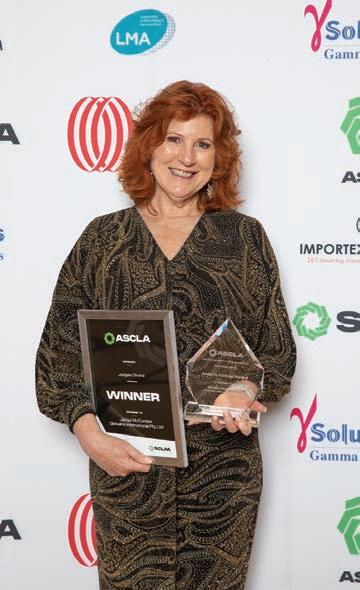
FUTURE LEADERS AWARD
Winners:
• Nives Gović
For Nives’ dedication to her career, her role, professional development, and industry involvement. Demonstrated through her public speaking classes, women’s mentorship programs and networking groups,
particularly geared towards AU-NZ women in business as well as the local and global level. Currently Nives is the Commercial Manager for DSV Solutions.
• Doreen Vrankar
For Doreen’s commitment and impact to the industry through developing new procedures, attending and running many seminars and work network gatherings, locally and globally. Doreen’s nomination was strongly supported and she has a reputation for excellent customer service that precedes her. Currently Doreen is Sales & Customer Service Manager at Globelink international.
Peter Jones speaks to MHD about whether the ongoing supply chain disruptions will drive network design towards centralisation or decentralisation, what these two business strategies entail, and their advantages and disadvantages.
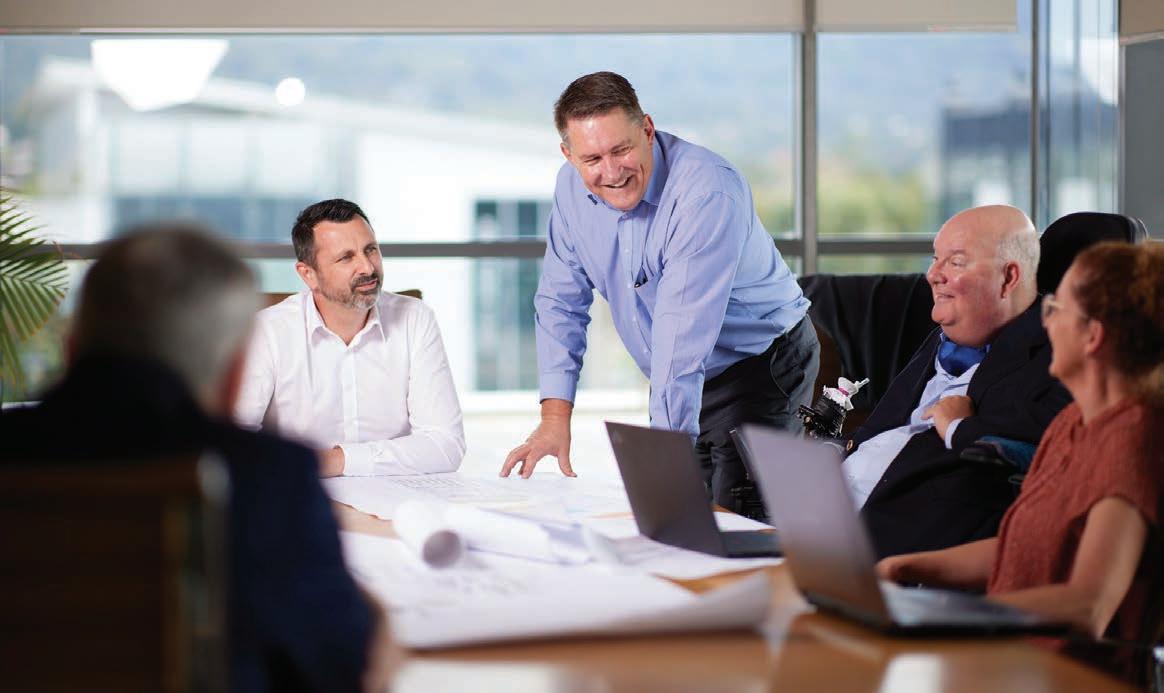
As e-commerce continues to exponentially grow and disruptions persist, businesses are needing to modify their network designs – including their supply chain models, warehouses and DCs – to deal with increasing consumer demand and new challenges.
Peter Jones, Founder and Director of Prological Consulting, says the changes made to supply chains to deal with the problems the COVID-19 pandemic posed will not be undone.
COVID-19 has been the disrupter that broke what were already fragile supply chains built on the just-in-time principle. Businesses have, since the GFC, assumed everything would work perfectly (most of the time) from purchase order through to fulfilment at every level of the supply chain globally.
The contributing factors to supply chain disruptions that ran in parallel with the pandemic over the past three years have included changes in the US foreign and geopolitical policies, e.g., withdrawal from the Transpacific Free Trade Agreement in 2020.
“The USA stepped out of several equally important treaties or agreements and moved back from existing agreements for the first time since the end of World War II,” Peter says. “This is not a commentary on the merit of these decisions, but it is an example of long-term stability (70 years of consistent policy) transitioning to something new in a short period of time.”
Other contributing factors are the ongoing ramifications of Britain’s
withdrawal from the European Union (EU). The policies rolled out over the past three years have impacted the UK economy – one of the largest in the world – now having flow on effects to the rest of the world.
“There’s been a bit of sabre rattling from some of the other EU members and the possibility of withdrawal from the European Union.
“China is taking a more Sinocentric view of the world while the RussiaUkraine War is ongoing. Russia and Ukraine are custodians of enormous amounts of globally critical resources, from energy to food to rare earth minerals that are required within the new economy, particularly for battery manufacturing and within the automotive industry.
In response we see businesses
engaging in new thinking and setting up contingency plans to recapture some level of certainty as they move forward.
“I believe that the COVID-19 influence will diminish soon enough. But it’s these other factors that will drive supply chain redesign into the next decade. The impact of these geopolitical influences is going to be much longer lasting and be more far reaching than the impact COVID brought about.”
Businesses can deal with the consequences of these geopolitical elements by developing greater levels of security for their supply chains, and one of the simplest ways of achieving this, is having the source of what is required as near as possible while also having the finished product as close to the customer as possible – for most businesses of scale, this will require more “decentralisation.”
Decentralising can result in shoring up of contracts, spreading critical elements, and de-risking supply chains from several angles. More inventory sits in the whole system as a business decentralises while energy, digital, and industrial relations failures become more manageable because, as in any decentralised environment, there isn’t a single point of failure that can bring a whole system down as is possible in a centralised environment.
“In Australia, post-lockdowns and after some businesses went under, there is now a trend away from centralisation and back towards decentralisation to some degree,” Peter adds.
The challenges are significant. The smaller your business, the more difficult it is to decentralise whereas the larger it is, the easier it is to accommodate. When a business decentralises, it needs more inventory, and it goes from having one facility to having multiple facilities.
Unless a business’s inventory is well controlled, its freight costs will quickly increase due to having to support the service promise via a transport network, sending direct-to-customer goods from a non-facing fulfilment centre or DC, rather than a facing one. This can become costly very quickly.
“There’s a direct correlation between freight costs and inventory control when a business decentralises,” Peter says.
Businesses also need to manage more
facilities so there’s a higher headcount as a ratio to sales. These challenges can be offset by increasing market share or sales within a growth market because of the better service offering a decentralised network offers.
“For businesses that are unable to do this, they’re going to struggle moving forward while businesses that can create an advantage through their supply chain to lift market share are going to have a far more agile, flexible, and responsive supply chain network. This is a key learning that has come out of these years of disruption. Smaller businesses can meet these challenges by finding good 3PL partners to fulfil their service requirements.
“Centralisation is a simpler environment to manage from inventory, staff management, and transport perspectives, and that simplicity is not to be underestimated. For a business to decentralise, it requires some maturity in its people, processes and systems and therein lies the risk.”
In an Australian and New Zealand context, fully decentralising will provide a business with the lowest freight cost possible, and a centralised network will come with the highest freight costs.
“The offset is from a warehousing perspective,” Peter explains. “When you only have one warehouse, centralised, your warehouse costs will be the lowest, but when decentralised, they will be the highest – the opposite to the freight cost equation.

“There are playoffs between warehouse costs and in multiplying a business’s footprint. Freight can offset the costs of warehousing and inventory. A
decentralised network affords a business a significantly higher service capability than a centralised one. There’s no prima facie case to say that decentralised network affords a far lower risk profile to a business plan than a centralised network. You have to do the work to determine the outcomes in each case.”
One of the major benefits of a decentralised network, Peter says, is that it’s more environmentally sensitive than a centralised network.
A decentralised network is environmentally lighter than a centralised one, mainly through reductions in transport emissions.
“By sending large volumes as replenishment orders, they create the option to use sea or rail freight or enabling weight and cubic ratio optimisation supporting good road transport utilisation. For Australian manufacturers, they can send bulk quantities to other states and territories in a decentralised network in a more efficient manner and then do all their last mile deliveries from a local environment.
“There is no one size fits all answer globally or nationally as to the centralisation/decentralisation question. In each business, someone must do the work involving infrastructure costs, inventory and freight for each of the potential options.
“Then the options have to be considered by the sales team (or driven by the sales team) as to the market opportunities various options may bring to increasing market share and ‘owning’ your customers because of the advantage developed in supply chain.
“All businesses need to create an unfair advantage through having a supply chain that serves their customers better than their competitors can.” ■
The Gold Coast may be known for tourist-filled Surfers Paradise, enthralling theme parks, invigorating sunshine, a buzzing nightlife, and pristine beaches, but it’s also home to some of Australia’s prime industrial real estate.
Marlon Crawford, Associate Director, Industrial and Large Format Retail and Matthew Adcock, Industrial Sales and Leasing Executive at Colliers, are the forces behind the sale and leasing of key commercial assets in the sunshine state’s second largest city.
Colliers on the Gold Coast covers a range of services for its clients. It provides appraisals and market updates, as well as delivering sale and leasing campaigns.
Its agents deliver clients an idea of where their asset sits in terms of the current market. Generally, a range is
provided rather than the exact value of the property. What has been seen of late is assets exceeding expectations and transacting above this range. The agents have many different sale methods when conducting campaigns – all tailored specifically to each property.
Fostering relationships is at the heart of Marlon and Matthew’s work – and has resulted in the pair working on some exciting projects.
Marlon tapped a local developer – that the team has a close relationship with –to purchase a site in Burleigh that was earmarked for a future supermarket by German chain, Kaufland. Kaufland chose not to enter the Australian grocery retail sector during the COVID-19 lockdowns, leaving an opportunity to transform the tapestry of the southern Gold Coast large format retail offering.
“It was a daunting time,” says Marlon. “We worked with the developer providing feedback and advice surrounding the highest and best use of the site. A large format retail scheme was crafted with the entire project fully leased to national tenants pre-Christmas 2021.
“Once fully let, the development was sold as a tenanted investment. Having worked on the site throughout the various stages, it’s helpful to carry over that institutional knowledge and experience of a property, even when working with different clients, and in our experience they appreciate the knowledge we bring to the table.”
Another recent campaign in the Burleigh Heads precinct is the strata unit development at 90 Kortum Drive. It is described as a man-cave project, with high exposure fronting Reedy Creek Road. The market response was strong, achieving record rates at that point in time. The project was sold out prior to
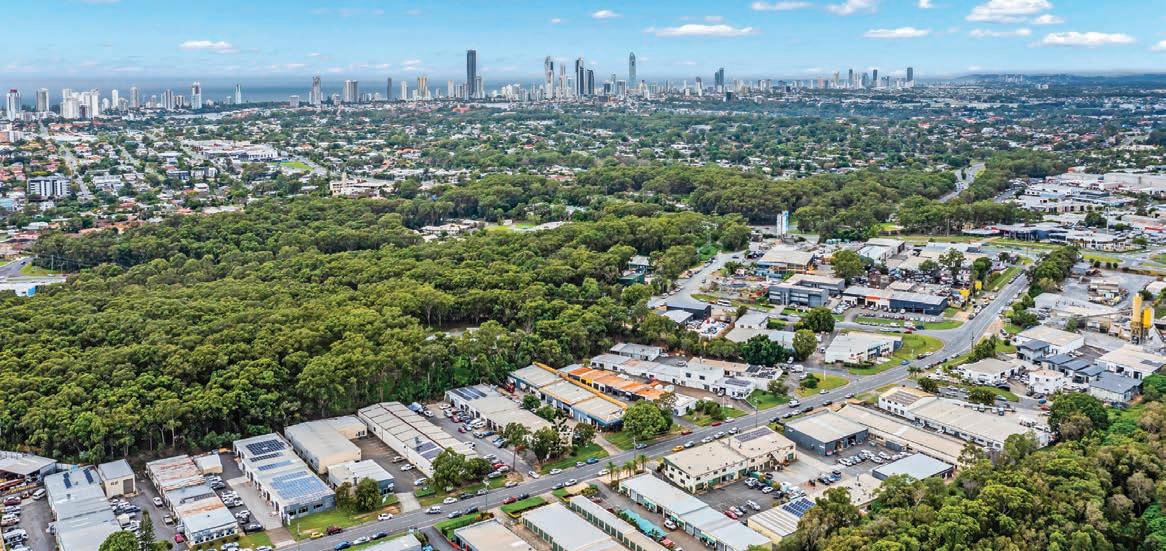
completion with more than $11.5 million in sales an excellent result for their client.
While Matthew only onboarded with Colliers several months ago, he has seen what the Gold Coast market has to offer, working closely alongside Marlon throughout the central/south sector.

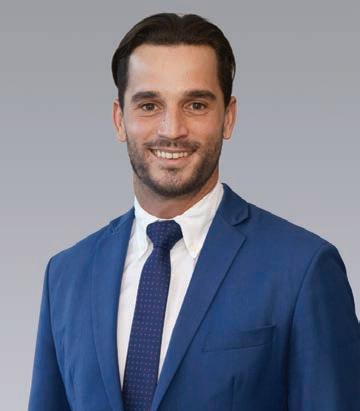
“I arrived at Colliers shortly after Marlon and Jacob wrapped up the sale campaign for 90 Kortum Drive and began working with potential tenants,” Matthew says.
“We were able to successfully lease multiple units, achieving record rates upwards of $330 sqm net. On the back of that we’ve been able to pick up a handful of units in the new Burleigh Head Quarters development along Burleigh Connection Road.
“Cracking 46-unit development with a mix of trade/retail, showroom, warehouse, and self-storage due to be delivered Q1 2023. On top of the leasing rates and sales touching $6000 sqm across multiple developments, Burleigh seems to be standing on its own as we’re still seeing people happy to pay a premium price due to the lack of opportunities to stay closer to home or that Burleigh lifestyle.
“There’s definitely some people who aren’t willing to match numbers with the Burleigh market though, as we’ve begun picking up some good traction on other and possibly more affordable projects across central Gold Coast like The Links Industrial in Carrara, which is another warehouse development with units ranging from 70-260 sqm.”
Marlon recently transacted two investment sales – one of them 13 Northview Street, Mermaid Waters, which was a unique offering in a tightly held exclusive pocket. The property is located
close to the upcoming light rail expansion on the Gold Coast, and a short stroll to the beach. Built in the 1970s, this 500 sqm besser block building backs onto a canal.
“We conducted an Expressions of Interest campaign and received 165-plus enquiries and 12 offers before the close date,” notes Marlon. “This demonstrates that the market isn’t all doom and gloom, demand is still out there for those quality assets. We ended up achieving a sale price above the previous valuation back in February which some might say was the height of the market.”
Another highlight was 112 Bundall Road, a freehold showroom and warehouse leased to a furniture business. It was sold as a tenanted investment with a very low yield due to being below current market rents. “We had it under contract, then it fell through.”
When speaking with National Storage about the Northview Street site where it has an existing operation, they spoke about the 112 Bundall Road, Bundall site, which sits directly next door to their current Bundall facility.
“I sent them the IM, they inspected the property, contracts were drawn up and it was all wrapped up 10 days from there,” Marlon explains. “National Storage was trading at 99 per cent occupancy, and it was bursting at the seams for more storage space.”
The Colliers Gold Coast agents have noticed the surfing city’s population boom during the past three years due to interstate migration driven by COVID-19 lockdowns.
“The population growth has fuelled demand for industrial property,” Marlon says.
“The government stimulus available and low interest rate environment was encouraging people to get into the market and purchase, there has been decentralisation from capital cities, and groups are more accepting of regional centres – which underpins this demand from our recent campaigns. Demand is still there, but commitment from the market has softened a little.
“I think now investors are factoring in further interest rate increases, the looming market downturn and I guess they are just happy to wait and see what happens over the few months. Interested
investors and renters are making plenty of enquiries about assets in Burleigh. Just like everywhere else, it’s massively undersupplied. There’s a lot of demand, but lack of opportunity.”
“We’re seeing premium rates across land, sales and leasing along the Coast because of this,” Matthew adds. “Rental growth on the Gold Coast can probably thank the high demand.
“In saying that, we are restricted on the Gold Coast due to the land scarcity of centrally located sites, rising construction costs are putting pressure on new stock coming to market, and low interest rates are encouraging investors to park their capital in real estate assets – there are so many factors driving rates upwards. Despite the premium rates here, the Gold Coast is cheap compared to other markets such as Sydney.”
The e-commerce boom and manufacturing problems coupled with supply chain issues in Asia, have prompted local businesses to ramp up their processes locally, which has benefitted the local Gold Coast and national Australian economy.
The Australian industrial market is yet to experience any downturn, notes Marlon, with only yields softening. “Land values, rental rates, and capital value rates will hold the same and probably continue to increase.”
“Trophy assets are still in huge demand with investors,” Matthew concludes. “The only trouble seems to be getting your hands on them.” ■
Contact Colliers today to learn more about the Gold Coast Industrial market and how to meet your property needs.

Supply chain consultancy, Pollen Consulting Group, joined Argon & Co in June 2022. Paul Eastwood, Managing Partner, looks back at what the company has achieved in the past six months, what it sets out to achieve in 2023, and predicts what challenges may lie ahead for the industry.
New Zealand of Intent Group to scale our footprint over there, and it really gives us the team size we’ve needed to compete in that local market.”
When Paul started Pollen Consulting Group, he says part of his vision was to have 100 people that love working for a consultancy business as much as he does. This is a milestone he’s now achieved. In the next couple of years, he aims to increase this number by 50 per cent.

Supply chain and manufacturing specialist, Pollen Consulting Group, joined Argon & Co – the global management consultancy specialising in operations strategy and transformation – in June 2022. December marks the first six months since the Sydney-based SME merged with the British-French business.
The Pollen integration came on top of the 2018 merger between the French Argon Consulting and the UK-based Crimson & Co – which formed Argon & Co. Paul Eastwood, the company’s Managing Partner, says significant progress has been made in the ANZ region in the past six months.
Paul says lots has changed within Argon & Co in the short period since the merger.
The old Argon & Co in Australia led
from a supply chain and planning point while Pollen Consulting Group led from a manufacturing point.
What hasn’t changed is the way the company behaves as a business – the fundamental approach to consulting has remained the same. When Pollen amalgamated with Argon, it continued to provide exceptional quality services to its clients by developing end-to-end solutions. But now, its capabilities have been amplified.
“A lot has changed in terms of capability,” Paul explains. “When we combined the two businesses, we had around 60 people in Australia and New Zealand. We now have 100. Since January, we added those extra 40 people, of which about 20 to 25 of them have been procured due to customer and capability demand.
“We also completed an acquisition in
“We’d like to add 250 new employees and deliver great results along the way. We don’t stretch ourselves or our capabilities too far. We are already supporting new sectors, but we are growing in a sustainable way such that we ensure we are always delivering on what we’re doing now before we take another step to grow the company further.
“We will evolve and move the market dynamics within those sectors, whether that means more growth towards the retail e-commerce side, where we’re seeing quite a lot of businesses need help to unpick what they did to respond to COVID and become more efficient in a long-term sense.
“We’re working with food and beverage businesses and we’re moving into other sectors, such as industrial and chemical. However, what we won’t do is suddenly jump into sectors we don’t really know or understand. We will only work where we can give real advice.”
The Argon & Co team is flexible and
services the whole of Australia, while catering to clients’ individual needs.
If customers have people working with them who have multiple sites in several locations, and prefer to use the same people, Argon & Co has the flexibility to service multiple locations.
“The business has traditionally been heavily weighted towards Sydney – where currently we have 60 people,” notes Paul. “We’ve got most of our team here. We now have just over 15 to 20 people down in Melbourne, with the office having opened in May or June. We continue to grow that office – it’s a priority and a focus.”
Some employees live and work remotely while providing regional support. Another 12 to 15 are based in the Auckland office, which is the main site for New Zealand with an additional eight spread around the North and South Islands.
Over the past six months, Paul says Argon & Co has grown while still retaining the cultural values upon which its original success was built: energy, pride, and humility. These are qualities staff show when working with clients and acting as partners. They proudly live and breathe their clients’ successes, Paul says.
“We’re making sure we don’t lose that entrepreneurial side of growth and thinking,” he adds.
“When you’ve got 50 people, you tend to know everybody and you tend to know everything that’s happening in your business, but as you grow and scale you need to put a little bit more structure around training and development of the team.”
Argon & Co has invested in and launched a graduate program because it sees the importance of growing capability in Australian supply chain, logistics and operations. “This will help us build our longer-term business.”
During these six months, Argon & Co has also moved offices, yet maintained the professional and polished look and the atmosphere it had when it was Pollen Consulting Group.
When Argon merged with Crimson in 2018, it envisioned a global consultancy platform focused on operations strategy and business transformation. At the time, its workforce was 250 to 300 employees. Over the last four years, it has expanded to 470 employees worldwide as part of the
company’s main strategy.
The strategy involved amalgamating with businesses, like Pollen Consulting Group, that share its values, talent, and commitment to excellence. It also means it can create a global footprint by using the underlying growth of the businesses and present service propositions globally, including opening new offices in locations such as Hong Kong, the Middle East, and North America.
Argon & Co’s key focus is to service Australian CEOs and to deliver business transformation. Some of its teams are working on capabilities and on growth strategies in this space. It has 500 staff globally and aims to expand this to 1200 in the next five to seven years.

“Our business has delivered some interesting and exciting projects in the digital twin space, which continues to go from strength-to-strength, as we work on different manufacturing footprints today, different warehouse designs tomorrow, and something completely new the day after.
“Traditionally, testing facilities isn’t easy, so the ability to build a facility in a virtual world before you go and put a lot of money into it has got some exciting value to it.
“We are building digital twins in Simio, the simulation modelling solution. It gives us a platform to create a 3D model of factories while running with real life variability – so you can go and see your future factory, and you can test it and see the risks associated with the design.
“It uses smart data analytics and modelling to replicate real life simulation,
and if you’ve done it 1000 times you learn it will be different every time – in the same way every day is different in a factory or a warehouse. So, it’s a vital tool in forward planning and future proofing your operations.”
In the next six months, Argon & Co plans to return to in-person events and meeting clients face-to-face.
“We’ll help our clients through the next six to 18 months of pressures. There are more dynamics to balance now than ever before. You look at today’s market and you’ve got sustainability coming in from one angle, you’ve got cost inflation, changing customer preferences and behavioural demand patterns, and the external macro impacts of what’s going on in the rest of the world.
“We need to think about having a lean operating model, how to set up the business for the future, and manage to balance all these priorities along the journey. An efficient platform is a sustainable platform.”
Paul says that the next six to 12 months is a defining time for Argon & Co’s clients and that Argon is ensuring it focuses on their needs and supporting them through the challenges and opportunities of 2023.
“I certainly look back over the last six to nine months and think it’s been an incredibly exciting journey, and one that has given me a new sense of energy.
“We’ve created a global management consultancy business. So, when we look back in five, 10 years’ time, we’ll have a global footprint of 1200, 1500, maybe 2000 people – and to know one of our offices in Australia played a key role in developing that is really cool to me.” ■

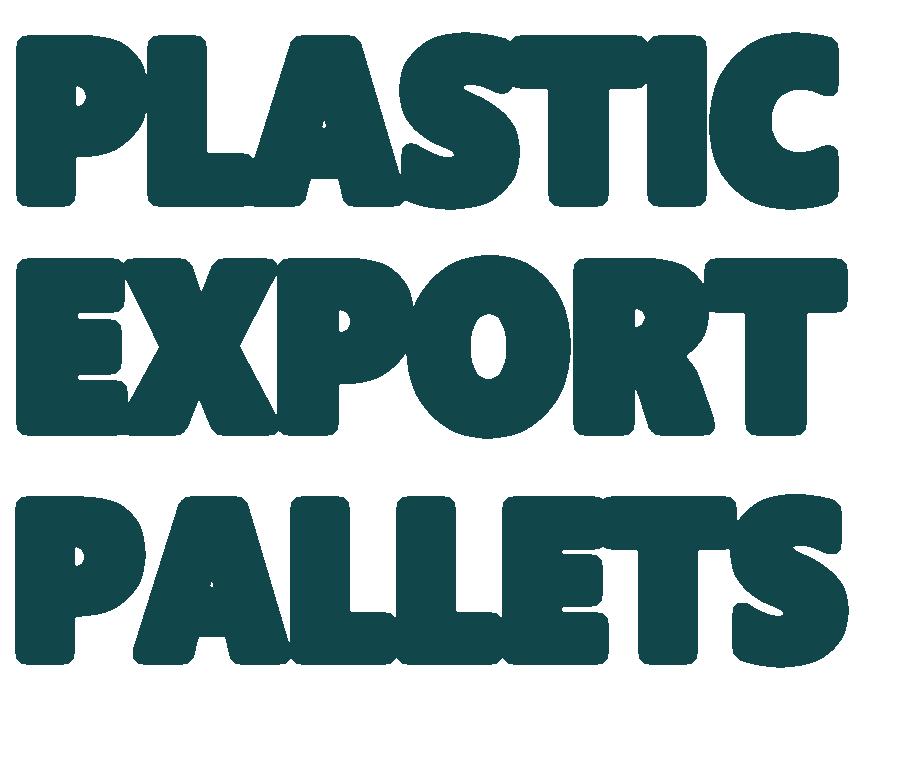


The growing pressure on companies to act on sustainability means that their supply chains are expected to be greener, too.

Körber Supply Chain on putting sustainability at the heart of the industry.
Over the past few years, Australian companies and their supply chains have been inundated with a growing number of disruptions, fuelled by megatrends such as globalisation, technological advancements and, most concerningly, climate change.

No longer something we can ignore, sustainability has become the key driver for business success and is essential to the positive public image of any organisation.
With increasingly environmentally conscious consumers now playing a central role in forcing companies to embrace sustainable business practices – including managing the environmental and social impacts of their supply chains – the time for our sector to act is now.
According to research by global market research company NielsenIQ, 73 per cent of consumers say they would either ‘definitely’ or ‘probably’ change consumption habits to reduce their impact on the environment. As Australian consumers demand products that are sustainably sourced through a supply chain that has a minimal impact on the natural environment, today’s operations are having to move quickly to ensure their business is more sustainable and ethical.
At Körber Supply Chain, we have seen first-hand how climate change has directly impacted our economy,
livelihoods, and health.
Disruptions caused by extreme weather events have had an impact on all regions and all sectors. Perhaps in no other sector has the impact of climate change been felt more significantly than within the global supply chain.
Here in Australia, the climate risks of greatest concern are rising sea levels, extreme rainfall and wind, increasing intensity of cyclones and tropical storms, and higher temperatures.
These risks have already resulted in coastal recession, flooding of essential public infrastructure, loss of transport access, heatwaves, and an increasing frequency of bushfires.
We all witnessed first-hand the unprecedented nature of the bushfire seasons of 2019 and into 2020. Key infrastructure was closed, including some highways and ports. Production lines were damaged, and consumer spending tumbled. Several key freight routes were closed, heavily impacting the supply of goods – forcing companies to find alternative routes. Further, data from AccuWeather estimates the total damage and economic loss caused by the wildfires to exceed $110 billion
To avoid similar devastation in the future, our supply chains must start to put sustainability at the heart of their operations today.
At Körber Supply Chain we are committed to making the world a greener place by building a more sustainable global supply chain network. For many years we have placed sustainability at the front of our minds and this trend will increase in the future, together with a focus on climate change risks.

As larger companies make public promises to become more eco-friendly, they are also holding their suppliers to the same standards. It is therefore more important than ever before that we all have a sound understanding of our processes and how our suppliers procure their goods.
To facilitate this, there are several practical solutions to make your supply chain more sustainable, reducing both your waste and your carbon footprint, and managing costs – all while increasing profitability. From pushing companies to rethink the use of plastic in packaging and increasing efforts to use recyclable materials, to overhauling vehicle fleets and making the move to electric vehicles, as well as introducing more automation to our warehouses.
Companies of all sizes and industries can introduce a variety of supply chain software and automation options to reach
their sustainability goals. Technologies such as autonomous robots, warehouse management systems, and artificial intelligence, will all play a critical role in allowing the continued functioning of a greener and cleaner supply chain.
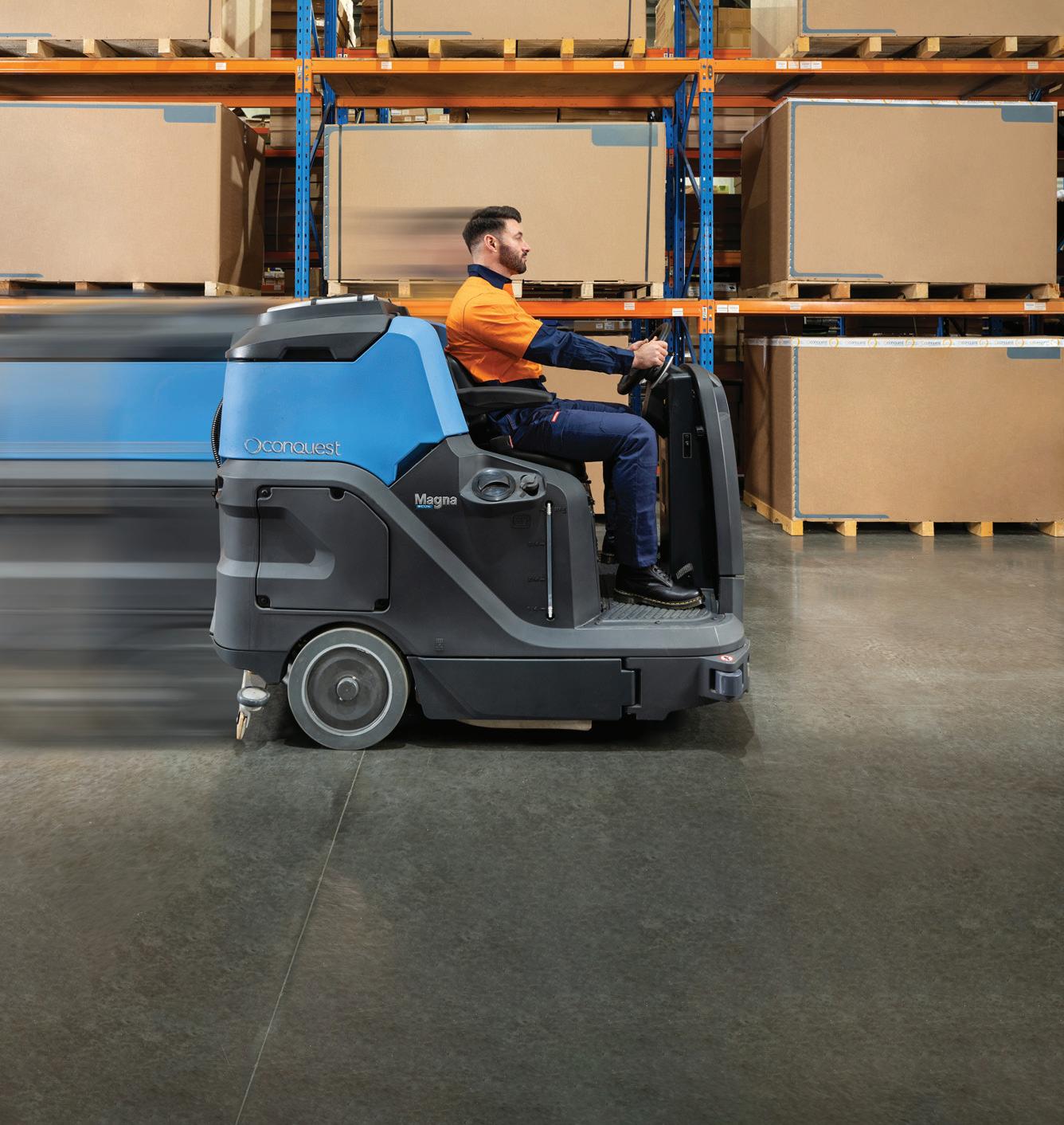
Advanced software and automation technologies will reduce energy waste in warehouses, shrink carbon footprint and decrease costs for both energy and materials. With the help of robotics –such as drones, Automated Mobile Robots (AMRs) and artificial data intelligence – businesses can increase productivity, efficiency, and product quality, as well as become more sustainable largely due to increased accuracy and reduction in energy consumption.
By keeping up with the pace of change and embracing the innovation in our industry, we must leverage the technologies available to us today in order to achieve increased visibility, energy efficiency, and waste minimisation across the entire supply chain operation.
As the demand for eco-friendly products and services grows, so too does the risk of companies overstating their sustainability credentials in order to attract and retain customers and investors. This is known as greenwashing – the practice of misrepresenting the extent to which a product or strategy is environmentally
We all witnessed first-hand the unprecedented nature of the bushfire seasons of 2019 and into 2020. Key infrastructure was closed, including some highways and ports.

friendly, sustainable or ethical.
With so much pressure on businesses to be greener, many organisations are trying to use their credentials on sustainability to gain a competitive edge. Recently, however, Australian companies have been put on notice about greenwashing after the Australian Competition and Consumer Commission issued its first ever fine for greenwashing.
While there has been an increase in investor demand for, and the availability of, sustainability-related products in the Australian market, there has been a growing risk of greenwashing. Greenwashing can take many different forms, ranging from exaggerated or imprecise claims to those intentionally crafted to deceive or mislead. Although initially used in the context of environmental statements, it now extends to broader sustainability concepts. It is therefore important that we, in the supply chain, comply with existing requirements when promoting or offering sustainability-related products.
The growing pressure on companies to act on sustainability means that their supply chains are expected to be greener, too. Research has shown that for most companies the supply chain is responsible for the bulk of their environmental
impact. By their very nature, supply chains often involve energy-intensive production and transportation, as goods are made and moved around the globe. Therefore, organisations can often make the biggest difference by making changes to their supply chain.
As the push for sustainable development gains momentum, driven by key stakeholders such as investors, financiers, regulators and customers – the scope broadens from mitigating climate risk to broader social considerations in line with global targets. As awareness grows about the need for sustainable development practices there is now a mounting focus on a broader spectrum of issues, which includes social and corporate governance concerns.
Developing and operating a sustainable supply chain strategy will help improve investor and consumer perceptions, manage costs and drive innovation, as well as build a resilient supply chain that leads to long-term financial viability.
It cannot be overstated how much making a change today will impact the future of our supply chains. Under pressure from consumers, competitors, and national and international regulations to meet better sustainability standards, supply chains should waste no time in ramping up their efforts to be both more sustainable and more ethical. ■

How a Toyota forklift is making life easier for NSW solar panel specialist.

energy storage technology, Paul was impressed by the batteries used in the Toyota forklift and the fact that he can run the machine inside his hangar without worrying about exhaust fumes.
Paul has outfitted his hangar with a comprehensive solar arrangement that allows the structure to exist off-grid, with all power for the building sourced through solar power.
That means his Toyota forklift essentially exists with zero carbon footprint, due to all charging being done on-site with electricity sourced exclusively through solar power.
Despite being a big investment for a small business, Paul’s forklift has been a great purchase for BlackLab Solar, helping him stay on top of logistics in the warehouse.
Asmall New South Walesbased solar energy specialist has turned to the classleading reliability and safety of Toyota Material Handling Australia (TMHA) forklifts to help his burgeoning business.
BlackLab Solar, based in Rylstone in central NSW, is run by owner and licenced electrician Paul Deegan and specialises in high-quality solar installation and maintenance.
Paul essentially does all of BlackLab’s installation, maintenance and ordering himself – a big enough job on its own, let alone when it’s being done without the right equipment.
After operating for a few years using an older diesel forklift bought from a neighbouring farmer, Paul made the choice to upgrade and purchase a new machine.
A former pilot, Paul was using his
hangar at Rylstone to store solar equipment following a period of heavy rain and needed a forklift that was ideal for indoor operation.
After looking at a couple of options, he quickly settled on an 8FBE20 electric forklift, with the material quality of Toyota products a big reason for the purchase.
“This new one’s been an absolute delight, it’s fantastic,” Paul says. “I wasn’t price-driven, I just wanted the best.
“Compared to the old one it’s a precision machine. You move a lever, and it moves exactly. It’s just great.

“Every time I get on it I just think ‘How good is this?’, because in the old days starting the business I was in Sydney and I had my kids handloading the solar panels, and now I’ll lift six pallets off a truck and it’s done in 15 minutes.”
Being an expert in battery and
Paul has now owned his Toyota forklift for approximately one year, and has been impressed by its precise performance and faultless reliability.
He also spoke highly of his relationship with TMHA and area sales manager Richard Bopping, who has helped to make the ownership experience as seamless as possible.
Paul says there were no current plans to expand the BlackLab business, but if he needed any new equipment, TMHA would be his first port of call, regardless of product.
A qualified electrician for 20 years, Paul started BlackLab Solar after working as both an electrician and pilot based out of Rylstone, including with the Royal Flying Doctor’s Service.
After flying planes for around 10 years, Paul re-entered the electrical industry with an emphasis on solar installation and ongoing service and maintenance, gaining qualification for solar, off-grid, and hybrid installations.
The company has an emphasis on producing solar installations of the highest quality, referencing the Benjamin Franklin quote: “The bitterness of poor quality remains
long after the sweetness of low price is forgotten.”
With the business placing such an emphasis on high build quality, it is no surprise that Paul gravitated towards TMHA, with impeccable reliability and durability a key tenet of the brand’s philosophy.
Toyota 8FBE battery electric forklifts have the latest control technology, coupled with an ergonomically designed operator compartment.
Outstanding energy efficiency has been achieved with new motors and drivers, to improve operating time by 20 per cent compared to the previous model.

Key safety features include Toyota’s System of Active Stability, to reduce the risk of tip-overs, and Active Mast Function Controller to limit mast angle and forklift speed according to load height and weight.

Despite being a big investment for a small business, Paul’s forklift has been a great purchase for BlackLab Solar, helping him stay on top of logistics in the warehouse.
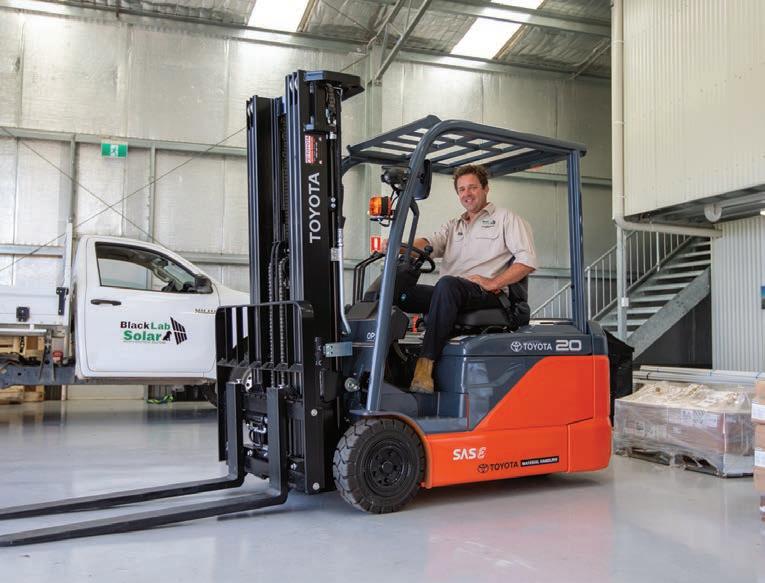
“It’s made a huge difference – I’m
43 years old and I’m almost singlehandedly running a million-dollar business,” he says.
“And having that machine, knowing I can jump on it, get the panels in the back of a truck in 10 minutes and I
know the thing is going to start – I know it appeals to someone like me.” ■


For more information freecall 1800 425 438 or visit www. toyotamaterialhandling.com.au

Combilift has gone from strength to strength in 2022. MHD speaks with Managing Director Martin McVicar and Country Manager Australia Chris Littlewood about the company’s growth, its sustainability achievements, and why pedestrian vehicles are in hot demand Down Under.
022 has been another record year for Combilift,” says Martin McVicar, Managing Director. “We’ve broken previous records in terms of both output and revenue, as well as in our employee numbers – we now have more than 750 people in our manufacturing plant in Monaghan, with another 130 or so overseas.”
Amidst supply chain uncertainty affecting the procurement of components for their path-breaking material handling equipment, Combilift has nevertheless continued to keep up the pace this year in terms of orders and innovation.
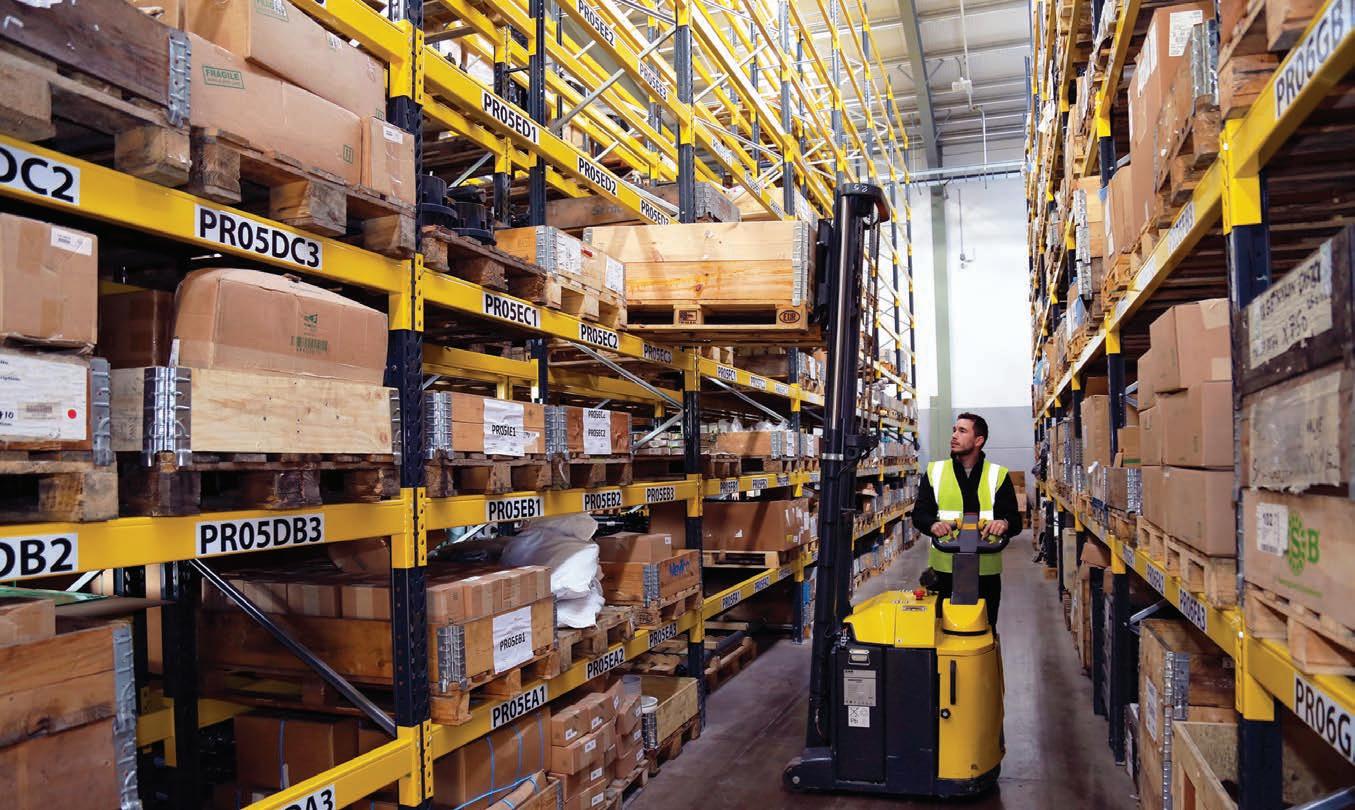
Ensuring the seamless supply of its products has involved taking a financial hit, in some cases, says Martin, but is worth it in the long term.
“It hasn’t all been plain sailing,” he says. “Anticipating the continuing supply chain challenges that would affect us this year, in 2021 we made a strategic investment to extend our factory and increase its capacity to supply more inventory on site. Having
that buffer stock of components has allowed us to get through some of the ripples affecting supply chains this year.”
In one instance, when the supply of a particular chip for the vehicle’s display panels appeared to be under threat, Combilift made alternative arrangements to procure the chips from another source – spending US$115 per chip compared with the standard three euros – in order to guarantee its ongoing production and delivery.
“That’s an extreme example, of course, and we haven’t done that in many cases,” Martin says. “It’s just one example of where it has cost us money to deal with supply chain issues or uncertainty – but we always keep our eyes on our longer-term brand promises even if it means taking a short-term hit.”
Martin and the Combilift team’s approach has clearly been sound, with the company winning the Manufacturing Exporter of the Year award at the Irish Export Industry Awards as well as being named one of
‘Ireland’s Best Managed Companies 2022’ by Deloitte – the tenth year in a row Combilift has been so named.
Part of the reason Combilift received these accolades is its continuing emphasis on sustainability objectives.
“For Combilift as an organisation, we’ve been really focused on how our products can allow our customers to make their businesses more sustainable, and our business proposition on this score has really resonated with our customer base – not only because energy costs are going up, but because every business has sustainability as an objective,” Martin says.
Combilift continues to put a lot of time, energy, and resources into its R&D programme, and the results are exhibiting themselves in its product range.
“In the coming year, more than 65 per cent of the vehicles we manufacture in Ireland will be electric powered,” he says. “With our R&D
investments, we’ve made it possible to have every model in our up-to10,000kg range available in electric powered. And in the last 18 months, the four new products we brought to market were all electric vehicles in different configurations.”
But aside from the electric vehicles themselves, Combilift has found other ways to assist the flourishing of other alternative-energies, developing heavy duty straddle carriers that can handle wind turbine blades of 100m in length and so effectively serve the growing offshore energy sector in Europe.

“We’ve been collaborating very closely with a number of bigger players in that sector,” says Martin. “And we’re starting to see interest and investment in Australia, too.”
Indeed, Combilift is already making inroads into the Australian solar panel industry by deploying its Container Slip-Sheet (Combi-CSS) for loading and unloading solar panels for import and export purposes.
Chris Littlewood, Country Manager, Australia at Combilift notes that the company has recently finalised an agreement with construction industry leader Monford Group for unloading solar panels at a large solar farm in Western Australia.
“The idea is that they’ll start using our Combi-CSS, powering it with a diesel generator, but then transition to using the energy generated by the solar panels they’re installing to drive the machine, because they’ll have 3000 containers to unload,” Chris says. “It’s a great example of sustainable use of a Combilift product

With the return of trade shows, Chris has been touring the country hearing stories from customers and learning what the market is demanding as we’ve emerged from the shadow of COVID-19.
“People are looking more carefully at what products they need for this point in time, particularly as it relates to labour shortage concerns,” Chris says. “For example, we’ve seen real growth in demand for our pedestrian units where they are an effective alternative to forklifts, because they’re easier to train personnel in, they’re adaptable for different purposes, and
they’re safe.”
Martin agrees with this assessment, saying that demand for pedestrian units has been growing across the world.
“Safety is not going away, it’s really at the forefront of every company’s mind,” Martin says. “One of the things we’ve realised is that if a company can move away from a sit-down forklift and to a pedestrian vehicle –especially in manufacturing facilities or in facilities where there’s a lot of personnel moving around the space –there is real energy to do so.
“One of the unique features we have with our range of pedestrian equipment is the tiller arm, so the operator does not have to stand behind the machine – they can stand to the side of it, and thereby eliminate the crush point.”
Part of the focus for Martin, Chris, and the Combilift team is to focus on the safety message as they continue to attend various trade shows, to keep getting the message out to the market.
“In Australia and like-markets, the message we hear and the message we deliver is that safety does not have a budget,” Martin says. “The reality is, if there’s a way out there to move goods more safely, companies are very interested, and for Combilift, we have really unique products that not only add value in saving space – which is of course important with scarce industrial property – but also allow customers to handle their goods more safely.” ■








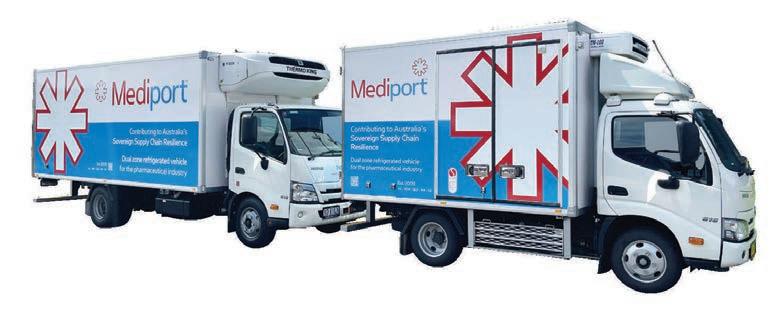

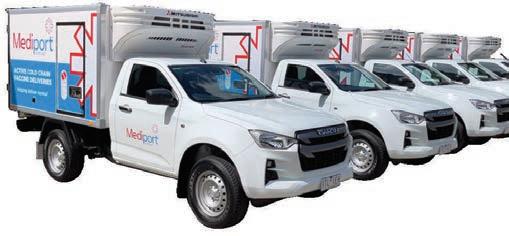

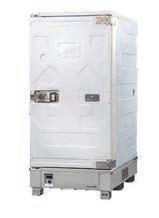
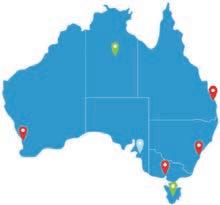
It feels like the only thing we can be certain of these days is uncertainty.
Over recent years, we have had extreme bushfires, the pandemic, flooding, a container ship blocking the Suez Canal for six days, and ongoing political instability. These events have caused a lot of uncertainty for both business and consumers, with interrupted supply chains, soaring costs, and fluctuating demand.
There’s a reason I’ve used the word
uncertainty and not risk. Risk is the known unknowns and is measurable. When risk is involved, you first identify what it is and then come up with a strategy to prevent it. People are employed to measure risk, such as actuaries, and manage risk, such as project managers. Risk gets a dollar value, whereas uncertainty doesn’t, because it’s unplanned and exposes any weaknesses in a businesses’ resilience and agility.
Today, disruption has become the new normal and there have been many flow-on
effects brought about by the uncertainty that comes with this. First, let’s look at some of the macro trends that many businesses in Australia may currently be experiencing.
“JUST
An environment with so much uncertainty is leading to consumers ordering a bit more of everything just in case, and this makes orders slightly bigger. The

switch from “just in time” to “just in case” has led to more inventory holdings where warehouses now hold a bit more of everything, just in case. This means warehouses need more capacity for maximum holdings, while also managing the big shipments that are on the way. With storage capacity demands increasing, there is a need for a larger footprint and smarter ways of handling greater inventory
While there’s been much talk about the “just in case” trend, we haven’t heard as much about the issue of land. We used to stress that availability of land close to your customers is strategic for maintaining high service levels. But today that’s seen as a great luxury if you can secure it. Instead, what we are seeing now is the availability of any warehousing space diminishing. Therefore, as warehouse renters approach their end of lease period, they’re facing significant bumps in costs to start a new rental period, but still going ahead and signing up because there’s now more value in having the right space and location locked in.
This is also an issue extending beyond rentals and impacting greenfield projects as well. As businesses outgrow their existing place, there’s limited available land to build something bigger, so they must instead focus on doing more with what they’ve got.
Labour performance used to be the basis for assessing the investment business case in a warehouse. What’s the pick rate, what’s the pack rate, how fast can someone move pallets versus a machine? What we’re seeing now is the high cost associated with not having enough skilled people to turn up and do the job, as businesses struggle to find talent during a time of low unemployment in Australia.
The issue now is less about manual labour performance rates and more about the business costs of low labour availability. What’s now evolved its way into the business case is attendance rates, agency fees and error rates. There’s training for new workers and then a ramp-up period before they’re productive.
If they don’t like the work, they move elsewhere, and the turnover cost cycle starts again.
In addition to the broader trends, there are also industry-specific trends that have arisen recently.
In Electronics, customers are loyal, until they aren’t. They want speed of delivery and will quickly move to a new distributor to save even a small amount of time.
Pharmaceutical customers order the same product from three distributors and then keep the first delivered, keep the cheapest, then return the third for free. That means if you’re not the cheapest, and not the fastest, you’ll pick, pack and ship the order, only for it to be returned the next day to be unpacked, sorted and put away all over again.
In Food & Beverage, some operators are experiencing an ageing workforce, but many of the bigger players are more preoccupied with handling growth in stock holdings and SKU proliferation, as customers acquire divergent tastes. This means they need to do more with the existing space they have. They also face customers with very high expectations on delivery and need to have full control over their inventory – because grocers will not accept deliveries out of date sequence.
In Australia, we’ve seen movement from 16 per cent to 19 per cent of consumer transactions being e-commerce, with close to 30 per cent in the UK, and 50 per cent in China. This is putting pressure on brands to have the products ready, plus fast delivery and being able to manage returns, which are a big challenge. Brands
are also having to step up to compete with online-only retailers who are starting to really step up their game in Australia.
In my experience, the businesses that have been able to manoeuvre most effectively through the challenges and trends that have surfaced over recent years are those that have considered the scalability of their operations and the agility they require to adapt.
These businesses have achieved scalability and agility through the use of robotics and automation. This may be in the form of automated guided vehicles (AGVs), at the introduction to automation level, Multishuttle systems that move smaller products and orders around the warehouse, AutoStore solutions for high density warehouse storage, right through to automated storage and retrieval systems (AS/RS) at the much higher level of storage automation for pallets.
While specific robotic and automation technology may vary from business to business, the fact remains that those who have built in this level of resilience to their operations have best positioned themselves to be able to trade, transact and maintain relationships at a time of endless disruptions and uncertainty.
Not only can smart warehouse design and operation strategies shield businesses from the potential pain of disruption, but we’ve also seen that it can help them to take a larger market share from those who don’t have the same agility and scalability. ■

THE WAREHOUSE IS CHANGING.
More item-level picking and returns. A dizzying amount of complexity. Demands for shorter delivery times. High workforce turnover. All these factors are putting you under greater pressure to fulfill more orders in less time with fewer long-term employees. That’s the new reality of warehousing.
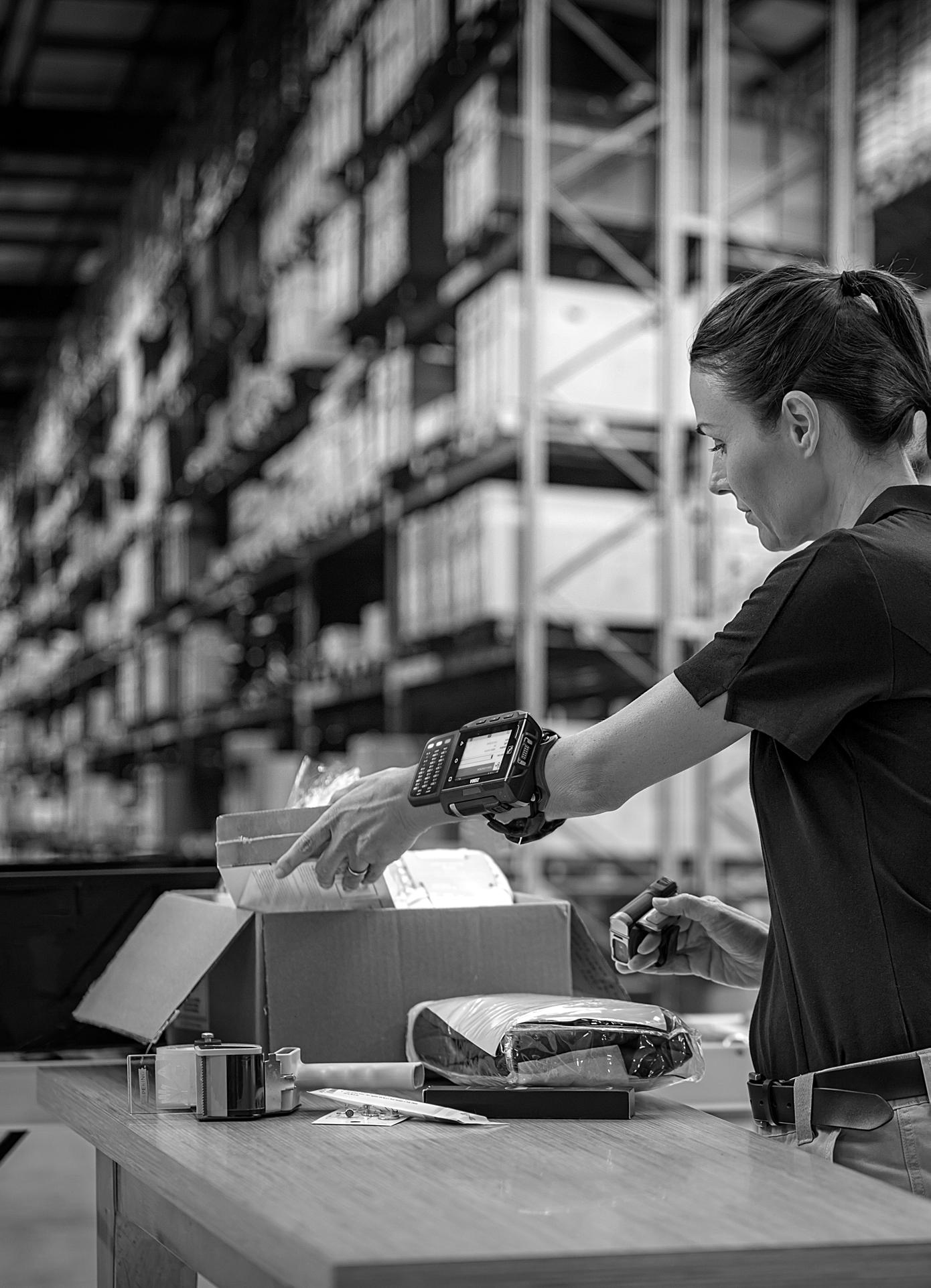
Our structured approach to wireless and mobility is focused on reducing cost, improving accuracy and enhancing quality. So when it comes to investing in next generation wireless and mobile technology, you can be confident of a solution that fits your budget.
www.skywire.com.au
Dexion’s High Density Storage (HDS) Shuttle is a scalable, flexible, and semiautonomous solution suitable for sorting pallets in warehouses and DCs. MHD found out what it offers from Jeff Darby, National Sales & Engineering Manager at Dexion New Zealand, and Anthony Barbara, Senior Product Manager at Dexion Australia, and Ed Randall, Principal, Dexion Napean.
out to recharge and replaced with another just like a power tool, reducing downtime, which would otherwise lead to a probable 20 per cent increase in the number of shuttles the business might need, adding to costs. For a fraction of the HDS Shuttle price, businesses can buy an extra battery or two.
Its alarm can sound at different stages of functions to advise or communicate to the operator what the shuttle’s status is – for example – it might indicate it’s on standby and is ready to be used, or that the battery requires charging, or there’s an error.
The Dexion High Density Storage (HDS) Shuttle is a semiautonomous solution designed for first in, first out (FIFO) and last in, first out (LIFO) operations.
The shuttle unit travels on support rails, transporting pallets within the system by retrieving and depositing pallets, controlled by the user via remote control. It incorporates various features to ensure safe handling, high reliability, and low energy consumption.
The HDS Shuttle is powered by a strong Lithium Battery that is lightweight and fast to charge, functional in ambient and cold room temperatures.
This solution makes the most use of limited space and provides quick access to stocks. It’s scalable according to the warehouse operations, throughput, and goods volume.

Dexion’s HDS Shuttle is the quickest unit on the market and its speed can be calibrated. If an item is a little taller and a little less stable, the user can slow the solution down whereas if the item’s compact and sturdy, the solution can be sped up.

It has a small, light, and removable lithium battery, which can be taken
Jeff Darby, National Sales & Engineering Manager at Dexion New Zealand, says uptake of the HDS Shuttle has been excellent in his home country and customers there understand the benefits of the system.
“Alternative solutions have had all sorts of issues like lack of bracing for racking systems,” he explains. “With New Zealand being a seismic country, the alternative solutions haven’t been suitable.”
The kiwifruit industry likes the efficiency of the operation due to the seasonal nature of the fruit, which requires a lot of produce to be stored in three to four batches within a short timeframe. The system is operated by presenting to only the front face of the system and saves time, as it doesn’t require the user to drive into it to load it.
“This combined with the high density
offered suits business operations, making it quicker, easier with less labour and reduced damage to stock,” says Jeff.
The dairy industry is also using HDS Shuttles in chillers and freezers, in cheese and butter stores, which are temperature controlled.
“The doors to the chillers and freezers are open for shorter periods of time. Workers open the door and leave them open while they batch load or empty the rooms. While the doors are open, there’s all this energy loss because all the cold is rushing out and the warmth is getting in, which results in higher energy bills.”
The HDS Shuttle speeds operations and offers optimised stock rotation because it can configure itself.
“The first product that you load goes all the way to the other end. And that’s the first out when picked from the other end,” Jeff adds.
“And it gives great separation between the inwards aspect of the operation versus the outwards. The two can have competing needs at times. Trying to operate in the same space can make it difficult. They’ve got that separation where they don’t come across each other.”
“We can effectively do end-to-end from the sale of the product to serviceability to the ongoing lifecycle management of the solution,” Anthony Barbara, Senior Product Manager, Dexion Australia, says.
“What’s good about the HDS is we understand the ins and outs of it so we can manage the parts locally or abroad. Our service teams can access the PLC programming so we can configure it to perform as required by the customer, without seeking permission from any third party to do this.
“Shuttles in warehousing are always the first step towards automating a warehouse. Many customers are using this sort of automated equipment for the first time. It gives them that step if they eventually want to go fully automated.
“We can provide specific information such as when it has been at the site, how many hours it’s been used, how many days it’s been working for –the information can be valuable for a business because they can find out if they’re overusing the technology, or if they need to expand, or if they’re underutilising it or not cycling the equipment properly.”
The HDS shuttle’s other advantages over conventional pallet racking include the fact that it’s safer and allows for much denser storage. This means the ROI pays off the cost of the machine within 12 months – even setting aside safety cost benefits.
“All the components can be readily purchased from any electronics or hardware provider,” Ed Randall, Principal, Dexion Napean, says. “That’s a big selling point, especially for remote users who can’t wait long times for spare components to arrive. They can buy and repair it locally. They don’t have to wait months for it to arrive from overseas or send it back overseas for repairs.”
With industrial rents continually increasing, the HDS Shuttle reaps better ROIs than other solutions because of its density of storage and flexibility. It can store more SKUs in a single space than Drive in Rack, as well as be used to handle raw materials, finished goods, enable ‘pack and hold’ operations and the staging of outbound goods for distribution.
Part of the ROI benefit results from the ease-of-use that attaches to the HDS Shuttle’s remote-control functionality which was designed with the customer in mind.
With a push of a button, the shuttle can go into an auto-store or autoretrieve mode for collection of pallets from the lane in a seamless fashion.
Shuttle racking can go up to 60-pallets-deep, providing very high-density storage.
operational face.
“Any damage sustained to the rack is visible and is easy to access to repair. The standard maintenance costs are very low compared to alternative systems like Drive-in which can be as much as 20 per cent of the total cost of the system per year so, customers are saying it’s cheaper to maintain.”
Jeff notes that Dexion’s larger clients have Occupational Health and Safety as a key priority and are looking to avoid incidents of racking damage from MHEs, that could cause it to collapse. The HDS Shuttle doesn’t involve driving in and out of a racking system, eliminating risk for forklift operators on site.
“The feedback we’ve received on the HDS Shuttle is that it’s efficient because it can be loaded and unloaded at up to six times the speed of the standard alternative of drive-in racking – so it’s significantly faster,” Jeff says.
Shuttle racking can go up to 60-pallets-deep, providing very high-density storage.

“The shuttles can be upgraded with a Battery Management System (BMS). If someone’s abused the shuttle battery, whether they’ve pulled it out-of-charge too early, or let it run flat too long, or let it sit for months on end, we can track the battery life cycle. It has good diagnostics for servicing and sharing information with customers on how their shuttles are being used.
“This means you have a reduced number of labour units. Speed is one thing, but lower cost to operate is another. There’s very little risk of damage to stocks, there’s no driving into the lanes – you just present to the
“This technology has been around for a while, so it’s certainly proved itself in the marketplace, and we’ve got a new offering on this shuttle, which is proving to be reasonably priced,” notes Ed.
“With Dexion HDS Shuttle, customers can be assured that we’re supplying a quality product at the top end of market, with aftersales service and maintenance,” says Anthony.
Reach out to Dexion at dexion.com.au to improve your warehouse operations. ■
When it comes to Industrial & Logistics space, three dimensions is only the beginning.

Scan the QR code to unlock insights from our experts on Melbourne’s Industrial & Logistics Land Supply

Glenn Sheppard, Mobility Solution Consultant at Skywire, talks about how modernising your warehouse technology enhances productivity and saves you money.

In warehousing, efficiency is everything. Every second shaved off your processes translates to productivity savings and bottomline gains. The explosion in online shopping has placed ever greater demands on the supply chain, and the drive to do more with less is top of the agenda for warehouse operators. For those who are still using older ‘brick-on-a-stick’ technology, there is a significant opportunity to drive productivity and ROI by switching up to newer devices. Far from simply a ‘nice to have’, today’s advanced warehouse technology is an investment that delivers a significant return.
At Skywire, we bring a wealth of knowledge around looking at a customer’s operations, their current mobility operations, and how to use technology to improve productivity beyond what was previously possible using a single purpose device for inventory management, stock picking, and other warehouse activities.
THE COSTS OF LEGACY Legacy, Windows-based mobile devices not only expose you to the security risks of an unsupported operating system (o/s), but their slower speeds, shorter battery life and lower memory put the brakes on supply chain operations – no matter how good your staff.
Moving to enterprise mobility devices – such as Zebra Technologies rugged mobility platform – which run modern Android o/s, opens up a world of productivity gains for the supply chain and delivers impactful ROI.
1. Fewer hardware devices – unlike ‘one device, one app’ legacy
systems, Modern Android devices can run multiple apps on a single device. So, alongside the Warehouse Management System (WMS), your staff can access, for example, email, leave requests, push to talk communication apps (like Zebra’s Workforce Connect), and safety checklists. This convergence of technology reduces the need for separate devices, reducing cost and reducing the number of devices users need to carry and access.
2. Productivity – the single device eliminates staff having to go backwards and forwards to check safety procedures or access email. They’re not having to switch between mobility device and radio. They spend more time on the warehouse floor doing their core job, increasing their productivity.
3. Health and safety – by digitising, for example, a forklift safety checklist, and making it available on the same device that your operator uses for scanning, it’s more likely to be checked and mishaps avoided.
4. Process efficiency – processes such as reporting damaged goods are time consuming with older tech. An Android device with a camera streamlines the process, and means your staff can manage the process end-to-end from a single device, saving time and cost.
5. Faster training/better operator experience – today’s warehouse workers, especially millennials, use touch screen tech every day. Giving them this familiar interface for their work device makes for faster training and a better operator experience.
6. Future ready – warehouse technology is advancing at a rapid pace. But legacy mobility devices
simply can’t take advantage of today and tomorrow’s functionality – including 2D scanning, NFC, wearable devices and voice picking systems. Even if you’re not yet ready to implement these advances today, investing in a Modern Android platform is a sound future-positioning strategy. Your investment will be protected, and you’ll be able to simply and rapidly implement advance tech and gain benefits such as:
• 2D scanning – Enables data capture from any orientation, reducing body movement and the risk of injury.
• NFC – Fast and easy ‘tap and pair’ functionality saves time when adding new devices such as mobile printers and accessories.
• Wearable scanners – Enable faster, safer scanning, with fewer RSIinducing repetitive movements and allowing for hands-free picking functions.
• Voice picking drives greater efficiency with staff not having to
check written picking lists and is particularly productive in small case picking and split picking operations.
So, you understand the benefits of stepping up to new warehouse tech, but how do you go about it? What are the next steps to ensure you make the right choices and implement a successful project? Here’s the three essential actions to take:
1. Modernise your WMS app – if you’re still using green screen tech, the first step is to migrate your app to a touch interface,
ready for Android. This process is made simpler if you use a Terminal Emulation (TE) program such as All Touch TE (ATTE) from Zebra. It will take your legacy apps and convert them to a modern, Androidready interface.
2. Select your devices – Zebra’s range of rugged, enterprise ready devices are certified by Google within the Android Enterprise Recommended program, providing you 100 per cent confidence that your selected devices will drive productivity and lower risk.
3. Select your partner – rolling out
a mobile device upgrade requires experience and expertise, and you’ll need to have the right partner to help you design, deploy, manage, and support your new fleet.
Selecting an Android Enterprise Approved partner, such as Skywire, will ensure that your project is in safe hands.
Having the right partner to roll out your mobile device upgrade is essential. Typically, the pain point will be most felt by CIOs and CTOs from an IT perspective who have registered challenges with their warehouse operations.
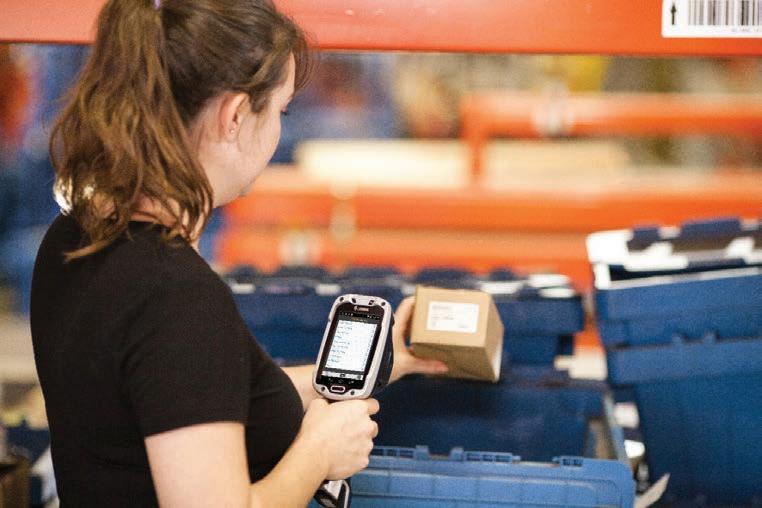

With more than two decades experience, Skywire has the longevity and the experience to make such a transition as seamless as possible. We currently manage 30,000-plus devices for organisations across Australia and New Zealand.
While we are premier partners to major mobility vendors such as Zebra Technologies – with direct access to the sales and engineering resources of those companies – we are staunchly independent and focus on providing the right solution for each unique customer. It doesn’t matter what WMS you use, Skywire has the experience, creativity, and expertise to modernise your warehouse to the standards required in today’s competitive environment. ■

Myriad supply chain pressures, including labour shortages and rising industrial property prices, are making the move towards automation more appealing than ever. But many businesses worry that the barriers to automation implementation are too high to overcome. BALYO’s Joshua Couturier and Mark Stevenson discuss how the robotics-innovator has made implementing automated forklifts easy and cost-effective for Australian businesses, large and small.

t BALYO, we believe in affordable robotic technologies, and we design, install, and operate simple systems and services to transport goods globally,” says Joshua Couturier, Sales Engineer at BALYO.
Since its founding in 2005 by two young engineers and robot enthusiasts, BALYO has focused on the transformative design, installation, and operation of simple and affordable robotic technologies based on standard OEM forklifts to transport goods in manufacturing operations, warehouses, and distribution centres.
“We believe robotic automation should be simple and easily accessible. We help our customers manage change with a low-risk transition to autonomy. We have been focused on automated forklifts since we began, and our partnership with two global OEM forklift manufacturers has allowed us to grow exponentially,” Joshua says. “We’ve had boots on the ground in Australia for one year now, and we are excited to serve the ANZ market with a personal touch.”
The genius of BALYO’s robots is that they transform conventional manual forklifts into autonomous robots by simply adding BALYO technology onto a standard forklift base.
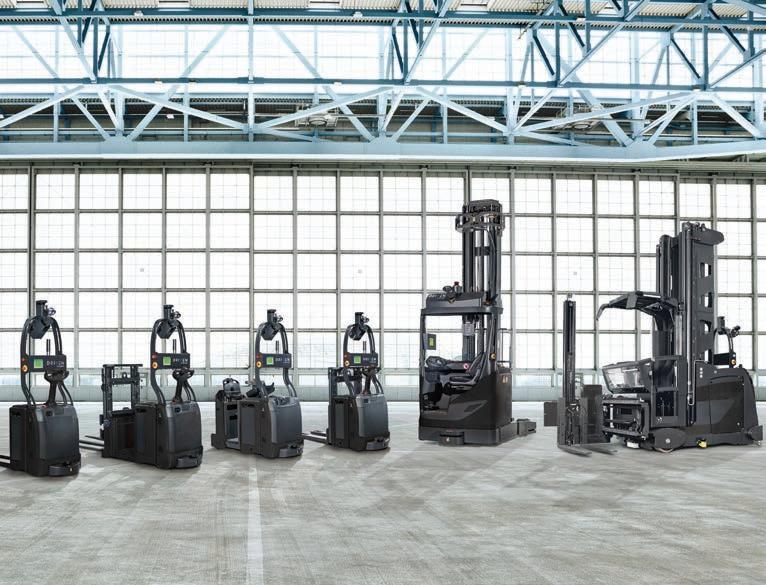
“We enhance standard forklift base trucks by adding cutting edge technology that has been fine-tuned through years and years of experience,” Joshua says.
“This experience has allowed us to
Compared to other options, the BALYO range of automated guided vehicles is more accessible for customers starting out on their robotic autonomy journeys – from both a financial and planning perspective.
position ourselves as a leader in high lift applications, with our automated reach trucks operating in the narrowest aisles, as well as our automated VNA robots serving up to 17m high racks.
“We help our customers manage change and stabilise their material handling labour requirements.”
In a way, BALYO is perfectly suited to the post-COVID-19 moment. It’s a truism to say that the world gets ever more complex by the day, but turbocharged pressures and added new complexities for companies that sell and move goods has underscored this notion.
“The pandemic has transformed the way the world operates and expects goods,” Joshua says. “Everyone wants everything faster and sooner. The
sheer volume of items that need to be housed and moved across the globe has increased exponentially, meaning warehouse and DC leaders need to reimagine everything from their layouts to operations to produce more output.
BALYO has the experience and global presence to help them manage these transformations smarter and more efficiently with the help of automation through robotics.”
Part of the BALYO appeal is that it radically lowers the barriers to entry to robotic autonomy – both financially and from a planning perspective.
“The most basic robot we offer is a tugger, which is able to pull trailers weighing up to seven tonnes,” Joshua
says. “Scaling up from there we have a range of horizontal transport stackers and counterbalanced stackers that are able to transport and place pallets of up to 1.6 tonnes up to four metres high.”
One of the most popular products in the range, Joshua says, is BALYO’s automated reach truck, which manages Australian pallets in storage and retrieval solutions up to 11m high in narrow aisles as little as three metres wide.
“But perhaps our most coveted solution features our Very Narrow Aisle (VNA) robot, which provides storage and retrieval solutions at the highest density up to a height of 17m – the highest available solution in the world.”
Joshua says that BALYO solutions wouldn’t be possible without the partnerships that provide the topquality forklifts or other material handling equipment to which BALYO adds its signature flair.
“Linde Material Handling is our OEM partner, providing us with the base trucks for BALYO autonomy,” he says. “Today we have more than a relationship – it’s a true, global, strategic partnership. We work closely together from concept, through product development and sales, through deployment to service.”
The Linde partnership means that BALYO’s trucks can be serviced by regular technicians accustomed to working on conventional manual models. And by teaming up to serve the customer, Linde and BALYO have the
experience and relationships to help each other in reaching that objective.
“When Linde customers in Australia decide that they need to change their operations and update their manual equipment to meet new demands, BALYO experience is ready to help bring their customers into the future,” Joshua says.
BALYO also has a key relationship with Körber Supply Chain – both globally and in the APAC region. “As one of the world’s largest systems integrators offering multiple solutions, Körber is able to help its customers move a step closer to the future,” he says. “And we are able to help them provide mobile robotic solutions that meet their customers’ needs.”
Joshua notes that the Australian logistics and supply chain market is growing at a rapid pace, which means that some businesses struggle to meet high demand as they are unable to find skilled workers, train workers, and retain their services in what is a competitive job environment in the industry.

Cost-effective automation by BALYO can help businesses cope with the pressure of skilled-labour scarcity.
“Automation helps in this respect, as you can have fewer operators on forklifts and redirect valuable worker energies to other value-added tasks,” Joshua says.

“Manufacturing is another interesting market in Australia where BALYO products can be put to good use, as many tasks are repetitive and travel distances tend to reduce the productivity of workers. Our lower horizontal application robots can provide relief to these businesses by taking on some of that burden from workers.”
BALYO products can also help tackle the challenges of industrial property scarcity and demand-driven price rises.

“Warehouse rents per square metre costs are reaching levels never seen before in Australia,” Joshua notes. “This impacts the supply chain and logistics space. To reduce costs, we recommend our clients look first at utilising all of their available space. For example, implementing VNA racks can
reduce ground footprint by utilising higher spaces. In this context, some customers may think this necessitates implementation of ASRS systems, but the reality is that under 18m an automated forklift is much less expensive and provides a much higher ROI on a much shorter schedule. So, I say to prospective customers, ‘Go with our VEENY solution; reach out to me to help build a solution and make a business case.’”
Importantly, he adds, BALYO will be there to flex and grow with companies throughout their journeys: “BALYO solutions are low risk, we provide an easy entry into a robotic journey, and we make it easy for our clients to scale up as well as across our clients’ entire local, regional, and global enterprises.”
Mark Stevenson, Chief Sales Officer at BALYO, says that part of the BALYO advantage is that by working with regional-specific OEMs, BALYO can help customers avoid some of the obstacles that attend automation solutions designed with non-Australian specifications in mind.
“Australia does have some very unique differences to other parts of the world,” Mark says. “The pallets are unique compared to European pallets or North American pallets. Also, some of the storage methodology isn’t necessarily different, but tends to be regionalised. For example, double deep storage with reach trucks as opposed to single deep storage, which is predominant in other areas.”
Mark says that many automated solutions have historically been purpose built in Europe, America, or other areas in APAC, without necessarily having the Australian end-user in mind.
“This can create additional complexities in terms of customisation for Australian purposes – particularly in the area of long-term support,” he says. “The unique thing about BALYO solutions is that we begin with OEM base trucks designed and produced at huge scale specifically for the Australian market. So, by adding autonomy to them, BALYO brings two advantages: one – the ability to have easy and affordable local service, spare parts, and maintenance ready to hand; and two – a local partner network that brings a high level of responsiveness to our customers.”


Kardex, the internationally renowned automated storage and retrieval solutions provider, is stepping up its presence in Australia. MHD caught up with John Sorohan, Director, New Business (ANZ) to discuss contemporary challenges facing Australian warehouses – and how Kardex can help.
Many companies can remain within their existing facilities while radically increasing their fulfilment and inventory capacity with Kardex solutions.

The scarcity of available industrial property is a key challenge facing Kardex’s Australian customers, says John Sorohan, Director, New Business (ANZ) at Kardex.
“There was a time not so long ago where you could just move further ‘out West’ in Sydney – but this is no longer the case,” John says. “Adequate commercial plots are a rarity and land values have increased rapidly. And it’s not just in Sydney; most cities in Australia (large and small) are reaching or are at capacity in many commercial segments.”
Compounding the challenge is the fact that labour is becoming increasingly expensive, and the right talent is harder to find.
“Many companies who have experienced online growth throughout COVID or who are forecasting high growth in the coming years are concerned that if they move to a new location, they will not be able to hire sufficient people to operate effectively,” he says. “Therefore, they choose to either stay in their existing facility or move to a new facility in the same area or close by. The latter can become a hugely expensive undertaking, especially if they do not own the land they currently reside on.”
John says that in this challenging
environment for businesses, companies are looking to various strategies to get the most out of an increasingly limited industrial footprint.
“One route is to try and create more space within their existing facilities,” he says. “As demand for space continues to increase, companies will need to look at utilising ceiling height to get more space in the same footprint.”
A second option, John says, is to expand or develop an existing facility. “However, such expansions come at a huge financial cost and often with significant interruption risk to the business.
“The third option is to rely more on third-party warehousing. As companies
move further away from urban centres, due to high operating costs, they will need to partner with 3PLs, as they have storage space in better urban locations, which assists in achieving quicker delivery times – but also comes at an increased cost.”
Finally, John notes that transforming retail spaces into distribution spaces is an increasingly attractive option –particularly with the rapid transition to more e-commerce. “Utilising existing brick and mortar store locations for fulfilment is becoming increasingly popular. Many retailers are now offering buy-online, pickup-in-store, and some are offering pickup-fromthe-carpark.”
For many companies, though, John says the best choice is to remain in their existing facilities but radically increase their fulfilment and inventory capacity. This is where Kardex comes in.
“Kardex is one of the world’s leading suppliers of automated storage and retrieval solutions,” he says. “We can provide modular, scalable solutions that increase order picking efficiency, reduce order picking errors, and optimise storage of goods all within a much smaller footprint than is possible with conventional manual warehousing.”
Having implemented more than 140,000 systems throughout the world, Kardex brings its global experience to bear on finding solutions for local customers in Australia and New Zealand, where it offers the largest portfolio of OEM products in the industry, combined with a full turn-key project delivery and service offering.
“Although a global brand, Kardex has a big base in Australia and New Zealand,” John says. “We’ve installed machines in over 400 sites and have implemented approximately 1200 machines.
“A typical project for the team at Kardex Australia begins with customer consultation to understand their unique business and operations, inventory data analysis, equipment delivery and installation, project management services – including System Commissioning and Go Live support – plus post-installation Service and Support to ensure your investment is protected for the long term,” John says.
John notes that Kardex Lifecycle Services has a commitment of delivering its partners a service at the next level of immediacy, combining global reach with local presence. Kardex’s Certified Technicians and Software Experts connect actively to resolve customer queries promptly, utilising technology such as the Kardex Connect Platform.
“Our Kardex Connect Platform allows us secure access to remotely diagnose and fix product issues,” he says. “We always focus on personalisation to align with our partners’ short- and longterm objectives. As a Trusted Advisor on the journey, we provide advice and support throughout the lifecycle of Kardex solutions.
“The beauty of our machines is that you can keep adding on as your inventory grows. Our software allows for additional machines to join the existing system. This really allows us to grow with the customer as their requirements change, and also means companies can start smaller than they might have anticipated, biting off a smaller chunk first before deciding whether to scale up.”
One product that John is particularly excited about in the Australian context is Kardex’s latest offering to the market: the newly upgraded Compact Buffer.
“The Kardex Compact Buffer sets new standards in terms of speed, precision, and energy efficiency, offering highlydense storage and precise picking for small parts and small-volume parts,” he says. “It is fully scalable with a low investment point and provides a wide choice of inbound and outbound automated interfaces to integrate seamlessly with both existing processes or technology and future automation. The entire transition process from design and planning to implementation requires a quarter of the time compared to similar systems.”
The new version of the Compact Buffer is configurable up to twice the length of the previous model (20m rather than 10m) and maintains high performance levels due to technology
upgrades within.
“Furthermore, it has doubled its capacity to more than 2000 bin locations per unit,” John adds. “Industries such as wholesale, retail, e-commerce, third-party logistics, and mechanical engineering significantly benefit from the fully scalable system. With a minimal starting investment, this fast, accurate bin picking and buffer system will increase storage capacity and improve picking performance.”
John joined Kardex in 2021 after 18 years at Dematic and is excited by the chance to be part of Kardex’s growth down under.

“Kardex Australia is experiencing terrific growth,” he says. “We see a lot of potential to provide new solutions for those small to medium businesses in growth mode.
“I think it’s a propitious time for Kardex to be expanding its presence in Australia, because our machines are ideally suited to the turn to e-commerce that many companies are contending with right now. We can install our machines into businesses that cannot or don’t want to spend $10 million on a new DC. Our machines are a perfect fit because they’re relatively cheap by comparison as a starting investment.
“And because our software is like a mini-WMS, if a younger business is paper picking, it’s a great entry stage into automated order fulfilment. We can save a lot of space, improve picking accuracy, and free up human labour time for more productive tasks.” ■






Eight years after beginning business with just one vehicle, Mediport was presented an opportunity to expand its offering when it was engaged to create a bespoke solution for pharmaceutical leader CSL in 2007. The then provider for the National Immunisation Program (NIP) in Victoria had concerns with the incumbent after a large breach highlighted some deficiencies in their processes. Ongoing discussions for the next two years resulted in Mediport becoming an active last-mile cold chain refrigerated solution provider in February 2009 – which it has remained to this day.
Owner and Director, Marcus Lethlean, explains that at that time, Mediport’s approach using active refrigeration was the alternative to the industry norm of using validated passive shippers with ice bricks and gel packs to keep their required temperatures over 24 to 72 hours (depending on mode of transport and geographic region).
The goal for Mediport was to form a new Active Coldchain Network. “The pharmaceutical logistics industry had been able to utilise the existing network of ambient vehicles to get around Australia either by air or road,” he explains. “It was the goal of Mediport to build a reliable Active Network in each of the capital cities and to link the most populated cities with overnight interstate transfers.”
After a successful one-month test period with one vehicle for the vaccine rollout in Victoria, Mediport expanded the hub-and-spoke format to regional Victoria and has since become the primary provider for the NIP in Western Australia, New South Wales, and – more

recently – Queensland.
Mediport uses temperaturecontrolled, validated, and monitored refrigerated vehicles. Importantly, cold chain medicines can be transported in standard recyclable cardboard cartons, avoiding the need to use polystyrene or polyurethane shippers. This has the added benefit of avoiding the need for reverse logistics to collect the passive shippers.
“Active refrigeration has a much smaller environmental footprint due to three facts: lighter consignments use less fuel to move around; the cardboard boxes are recycled; and there is only one delivery to the customer – no collection is necessary,” Marcus says.
Together with environmental benefits, cost reduction and efficiencies are proving a strong incentive for wholesalers and manufacturers to use Mediport.

After years of successful operations
as an intrastate deliverer, Mediport has recently launched its capability for interstate delivery, ensuring a seamless cold chain logistics journey for pharmaceutical products.
“Dual temperature zone 2, 6, 8 and 14 pallet trucks allow cartons and pallets to be transported overnight for next-day interstate delivery from Sydney to both Melbourne and Brisbane and vice versa,” Marcus says. “This takes advantage of our waiting active cold chain fleet, which can deliver goods at a range of up to three hours out of metro areas. A customer order in Sydney at 2:00pm will see the item delivered in Maroochydore at 9:00am the following morning, and under our cold chain control the entire way.
“We use halfway point vehicle exchanges in Kempsey (halfway to Brisbane) and Tarcutta (halfway to Melbourne) to allow the interstate drivers to return to their homes after driving,” he says. “This allows the transport of the cartons for our van drivers and pallets for
MHDMarcus Lethlean, Owner of Mediport.
the local wholesale orders. Orders inherently are delivered within 24 hours of an order placement.”
Facilitating the last-mile, end of manufacturing, patient care, and delivery components of cold chain medicine, Mediport hasn’t restricted itself to cyclical vaccines. Its service extends to delivering other cold chain medicines including insulin, blood products, cancer treatments, and lifesaving drug programs.
“The last 14 years has seen a growth in society’s receptivity to vaccines, which has aided business growth,” Marcus says. “Other clients began to see a benefit in a uniform quality standard, and this support saw Mediport expand nationally. We grew our network across Australia and once we added enough volume, we purchased facilities and built our own validated cool rooms for storage, sorting, despatch, and delivery.”
Today, Mediport has 80-plus vehicles – with more being added to the fleet as required.
The business maintains a validated ISO 9001 Quality Management System and employs drivers rather than subcontracting labour. This has been necessary to ensure the GDP requirements of its ISO 9001 QMS are embraced by staff using validated company vehicles.
In August 2021, Mediport was awarded a grant under the Sovereign Supply Chain Resilience Scheme. This grant contributed to the design and build of an additional 28 dual temperature zoned vehicles, able to carry vaccines and cold chain medicines requiring 2-8 and 15-25 degrees Celsius medicines in the same vehicle using two independent zones.
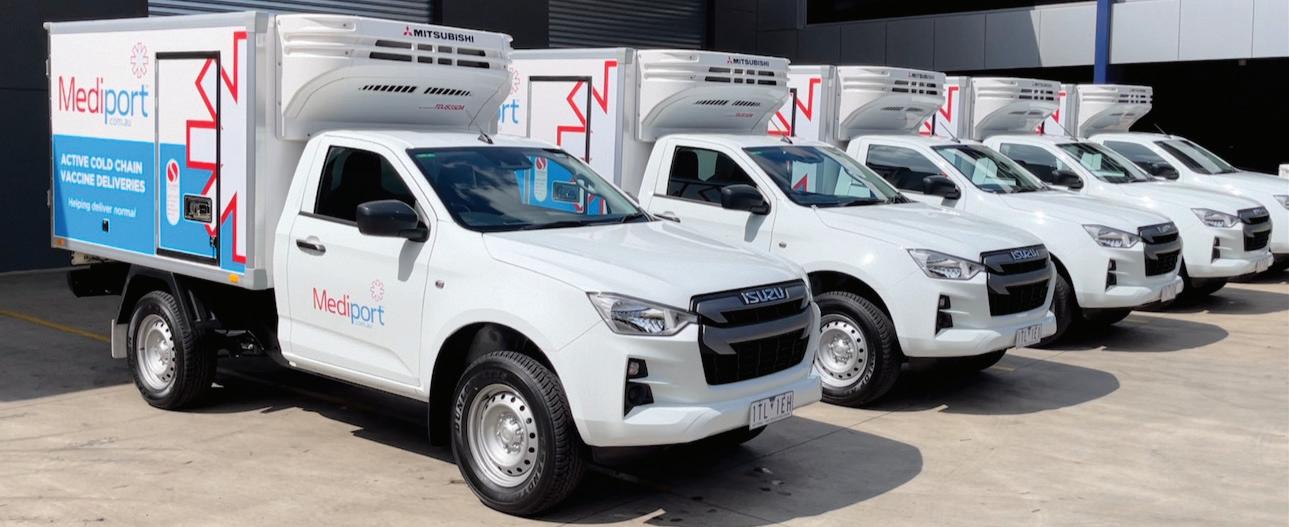
The establishment of the overnight interstate deliveries has extended the use of active cold
chain away from the use of passive shippers.
The first interstate Hybrid Hino truck, currently being built, is a welcome addition to the ethos of the Mediport, Marcus says.
The use of Coldtainers has resulted in an expansion into Tasmania for the Department of Health, contributing to a considerable reduction in transport and packaging costs.
Western Australia has a new facility with coolroom currently under construction, ready to enable storage, sorting, despatch, and delivery from Canning Vale by the start of December.
Further investment in online training systems for the QMS and the building of the iOS Driver App called Fit logistics will all help contribute to supply chains when next there are challenges to flight schedules or disruptions due to high demand in courier and postal services.
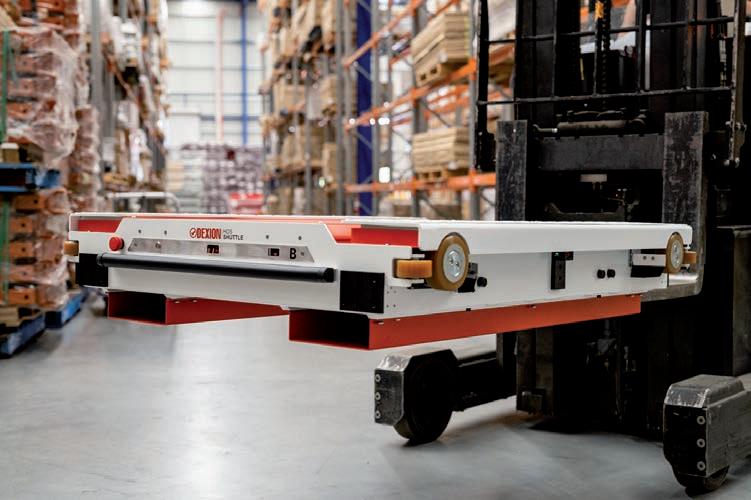
A great source of pride for Marcus is the absolute conviction and sense of purpose shown by the entire team. The service level is maintained by the entire team, but with a focus on the last mile, which is executed by Mediport’s driver team.
During the COVID lockdowns, eight airline pilots joined the team in NSW, WA, and QLD –making an incredible contribution and applying their skills in new contexts while awaiting the chance to return to their chosen vocation.
“Among the existing team, there are former directors and leaders of companies from a variety of industries, all of whom want to contribute in a very tangible way, and that’s a great testament to what is taking place at Mediport,” Marcus says.
“After 14 years it certainly feels that the receptivity to an active Coldchain solution is on the rise. We are thrilled to be in the position to provide the service, one from which business and the environment both benefit.” ■
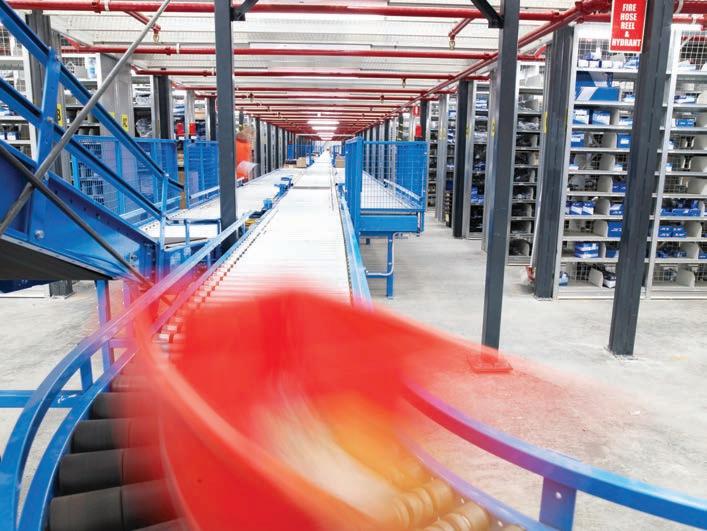
“
Among the existing team, there are former directors and leaders of companies from a variety of industries, all of whom want to contribute in a very tangible way, and that’s a great testament to what is taking place at Mediport.
”





With Labor winning the federal election on 23 May 2022, the Refrigerated Warehouse and Transport Association of Australia (RWTA), has made a move to ensure that the Australian Cold Chain is visible in Canberra to the Albanese government by holding meetings with parliamentarians in September.


There were multiple meetings
in Canberra, where the RWTA introduced itself to the new ministers and discussed labour shortages and energy costs. To date, these meetings have resulted in five ministerial visits to cold chain companies around Australia.
The RWTA had invited Sussan Ley, Deputy Opposition Leader, Senator Michaelia Cash, Senator Slade
The RWTA has requested of the Honourable Nola Marino MP
Brockman, Ian Goodenough MP, and Bridget McKenzie to take a tour of a cold chain facility to get an insight into the inner workings of the cold chain process. and Senator Glenn Sterle that they consider hosting an evening at Parliament House in February or March 2023.The event would foster constructive dialogue between the sector and parliamentarians to recognise the industry as vital to Australia’s interests. The industry would benefit from understanding the level of interest in its sector by Australia’s policy makers.


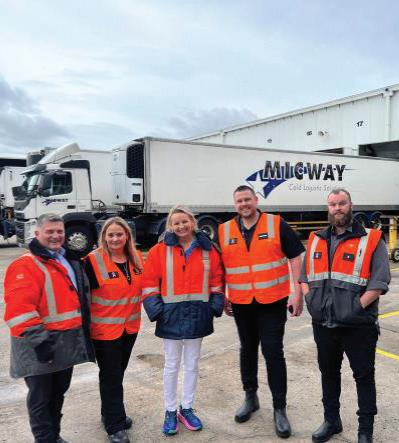
I encourage you, when this event is announced, to attend and represent this vital sector and have a united voice. ■

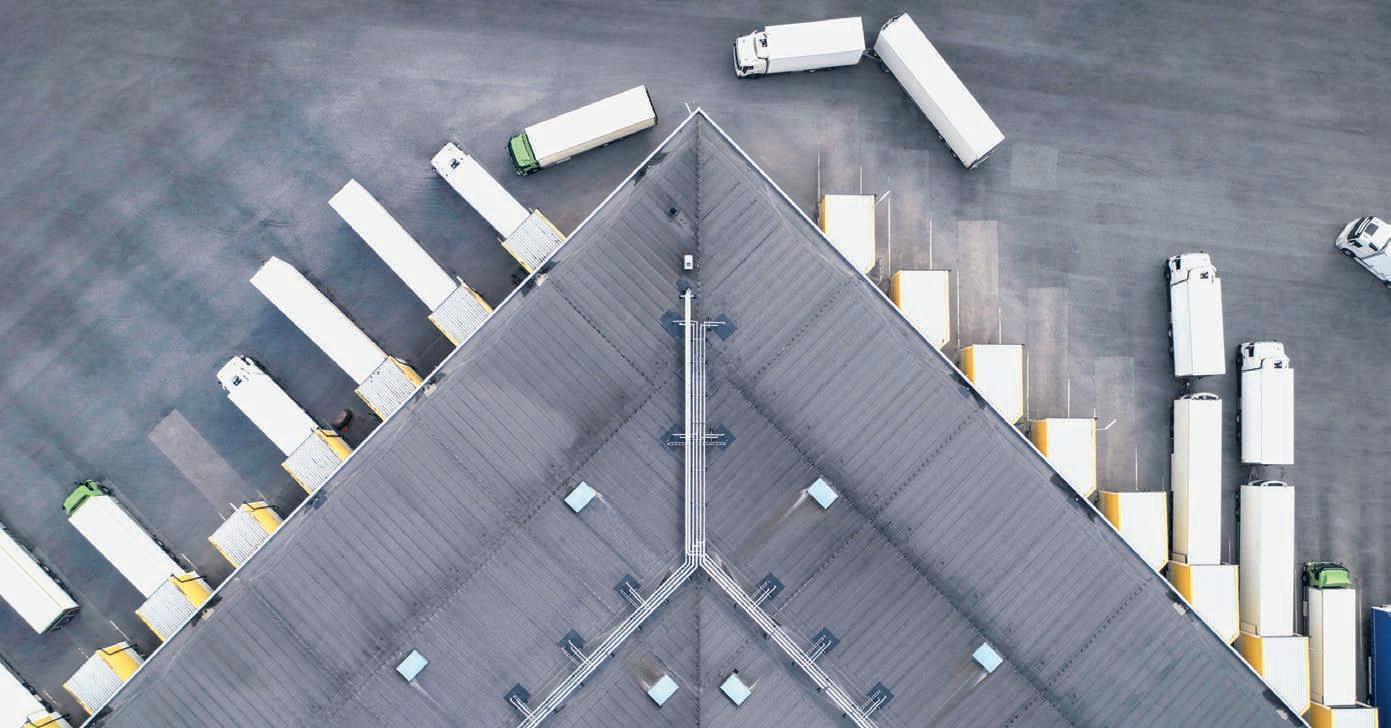
Completely redesigned and enhanced, the Geotab GO9 device is optimised for the collection and analysis of near real-time vehicle data. The GO9 features a faster processor, more memory, and a gyroscope. Expanded capacity allows even more and ongoing vehicle support, including better fuel usage support, and increased electric vehicle compatibility. Using Geotab’s patented tracking algorithm, the GO9 accurately recreates vehicle trips and analyses incidents. The GO9 also offers in-vehicle alerts to instantly notify drivers of infractions and –with hardware Add-Ons – provides live coaching for driver’s on-road performance.


To find out more, visit www.geotab.com/au/vehicle-tracking-device
Since Combilift launched its first C4000 model in 1998, multidirectional capability has been one of the major hallmarks of the company’s wide range of handling solutions. 24 years and thousands of R&D hours later, its latest product takes multidirectional capability to the next level. The Combi-MR4 is a 4-wheel electric powered multidirectional reach-truck, which incorporates Combilift’s new Dynamic 360° ™ steering, which provides rotation on each wheel, enabling seamless directional change of the truck while on the move. The system allows this extremely agile forklift to work in forward, sideward and crab steer mode, guaranteeing swift operation and excellent manoeuvrability. Hence the full name of the new model: the Combi-MR4 Dynamic 360.
For more information visit www.combilift.com/combi-mr4

Poor ocean visibility puts a strain on global supply chains, logistics costs, and customer service. At the root of the issue is low-quality data that hinders personnel productivity, streamlined operations, and proactive exception management. Today, more than ever shippers and 3PLs need global ocean visibility with the data quality, intelligence, ETAs, and proactive exception management that ensures efficient, costeffective, reliable, and sustainable global transportation. Project44’s Ocean Visibility solutions is here to help, with a suite of solutions that uses first-in-class data and analytics to improve personnel productivity, allow for proactive exception management, reduce logistics costs, improve customer service, and empower users for agile transport planning and procurement.
For more information visit www.project44.com
The Dexion High Density Storage (HDS) Shuttle offers high density pallet storage without the use of forklifts. The shuttle unit travels on support rails, transporting pallets within the system by retrieving and depositing pallets, controlled by the user via remote control. The HDS Shuttle incorporates various features to ensure safe handling, high reliability and low energy consumption. This solution makes the most use of limited space and provides quick access to stocks. It is scalable according to the warehouse operations, throughput and goods volume.

For more information visit www.dexion.com.au

A monthly wrap up of the latest appointments in the supply chain, materials handling and logistics industry.

Noah Bernardi has joined the New South Wales team of global property services firm JLL as its Executive in the Logistics and Industrial Agency. He has more than two years’ experience in the commercial real estate industry and has worked at Knight Frank, where he was Sales and Leasing Executive. In his new position, Noah will service the South Sydney market where industrial sites in the area are becoming increasingly rare. He will cooperate with other members of the South Sydney team, including Murray Pettinger and Mark Silva.

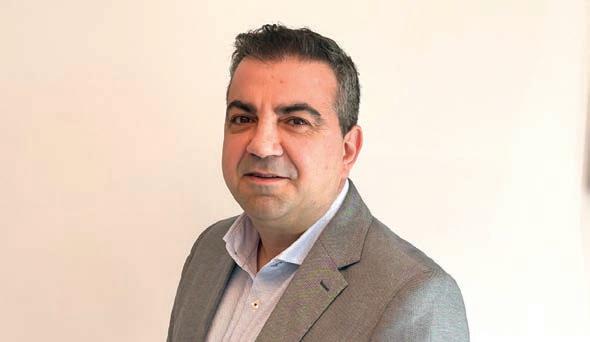
Peter Tebelopoulos, a long-time Merchandise and Supply Chain Planning expert is TMX Global’s new Director Supply Chain – Planning. He previously worked at Kmart Australia for 12 years in Planning Manager roles and most recently as Head of Inventory. Prior to that, he worked in senior roles for Myer in planning and merchandise. He brings to the role 20 years’ worth of industry experience and has strong exposure across both local and international sourcing and supply chain models, managing portfolios of more than $1.4 billion, and the entire Kmart merchandise range as Head of Inventory.
Do you have career news to share? Email Edward Cranswick at Edward.Cranswick@primecreative.com.au to be featured.


